2025/03/21Number of reading(32820)Number of comments(0)
一、Target Audience
Operators, Ad Specialists
二、Feature Introduction
Keyword targeting is the most frequently used advertising method for Amazon sellers. By targeting keywords, sellers can match user search terms and target their product ads to gain more impressions and clicks. Most sellers run multiple campaigns, targeting varying numbers of keywords. However, managing a large number of keywords can become cumbersome. Sometimes, checking the performance of a single keyword might require opening multiple campaigns or downloading numerous reports.
To address this issue for our sellers, we launched the 【Targeting - Keywords】 feature. It automatically synchronizes all keyword targeting data from your Seller Central account, allowing you to view and analyze the performance of ad keywords across all your stores. It also supports bulk management, enabling you to add ad keywords, ad products, and implement negative targeting.
Furthermore, SellerSpace integrates with SellerSpirit's 【Keyword Research】 feature. Directly within the 【Targeting - Keywords】 function, you can view and analyze the relevance, market competitiveness, search volume, and purchase volume of your targeted keywords. This helps you quickly decide whether to continue targeting or negate a keyword.
三、Synchronization Mechanism
1. After successful authorization, advertising data from the last 60 days is automatically synchronized from Amazon via the official API within approximately 2-3 hours, and data is updated roughly every 30-60 minutes.
2. Once the initial 60-day data synchronization is complete, data from the last 2 days will be updated approximately every 30-60 minutes. Data from the last 3-60 days will be updated daily, based on Amazon's advertising attribution window.
3. Unlike Amazon, which only retains advertising data for the last 2 months, SellerSpace retains all synchronized advertising data for seller analysis and reference.
Data synchronization via API involves a time lag, especially when new ads are created or adjustments are made in Seller Central. These changes are not reflected in SellerSpace in real-time. In such cases, you can manually synchronize data for immediate updates.
How to manually synchronize? Click here to view
四、Use Cases
- View and analyze the performance of ad keywords across different dimensions.
- View and analyze the market competitiveness of ad keywords, etc.
- Add targeting keywords for one or more Ad groups.
- Adjust bids, Enable/Pause status, tags, etc., for ad keywords.
五、Operation Guide
1. Viewing and Analyzing Keyword Performance
1.1 Manually Synchronizing Data
For analyzing ad performance, data timeliness is crucial. In addition to automatic synchronization of Amazon advertising data, if you notice data synchronization delays, you can manually synchronize to obtain real-time data promptly, aiding in accurate ad performance analysis.
Each marketplace allows a maximum of 3 manual synchronizations per day, with a minimum interval of 30 minutes between each synchronization.
① How to Determine if Automatic Synchronization of Ad Keywords is Normal
If you suspect data anomalies but are unsure, you can check the latest synchronization time of the advertising data to confirm if synchronization is normal.
Hover your mouse over 【Last Updated】 to directly view the latest synchronization time for all advertising data types.
 +
+
If synchronization is abnormal, for example, for Sponsored Brands and Sponsored Display ads authorized after initial authorization, click 【Refresh】 to resynchronize.
 +
+
② When Advertising Data is Modified in Seller Central (All Ad Modules)
If you modify ad information in Amazon Seller Central, such as campaign structure, name, budget, bid, ad placement, start/end dates, or status, the system will not perform real-time synchronization updates.
Information changed in Seller Central will be automatically synchronized once on the first access to the SellerSpace ad management page each day, and then every 6 hours thereafter (different from advertising data updates).
However, you can manually synchronize this information immediately. For keyword targeting synchronization, the operation path is: Ad Management -> Targeting - Keywords -> Select Keywords -> Synchronize Status or Bid.
 +
+
③ New Ads Added in Seller Central (All Ad Modules)
If you add new campaigns, Ad groups, promoted products, keyword targeting, or non-keyword targeting in Amazon Seller Central.
The system will not immediately synchronize updates. Updates will only occur when the ad object receives impressions.
However, you can also manually synchronize this information immediately. For synchronization of newly added targeting keywords, the operation path is: Ad Management -> Targeting - Keywords -> Manual Data Synchronization -> Basic Data Synchronization.
 +
+
Additionally, due to Amazon's advertising attribution window, advertising data may still fluctuate within 60 days after it occurs.
The system does not synchronize historical data in real-time, so discrepancies may exist when viewing non-real-time advertising data.
You can manually synchronize historical advertising data using the 【Report Data Synchronization】 feature.
 +
+
1.2 Setting Tags and Watchlist
Before viewing and analyzing ad keyword performance, you can set up tags and a watchlist in advance to categorize and manage your targeted keywords, facilitating quick searching and analysis.
① Setting Tags
Tag settings include: adding individually + adding in bulk.
Adding Individually: Find the keyword you want to tag, click 【+】 under the "Tag" metric, enter a tag, or select an existing tag to add.
 +
+
Adding in Bulk: Check all the campaigns you want to tag, click 【Set Tags】, then enter or select an existing tag in the pop-up window, and click 【Confirm】 to save.
 +
+
② Setting Watchlist
You can add keywords that require focused attention to your watchlist. Once added, the data for these keywords will be displayed at the top for direct viewing and analysis. When adding multiple keywords, they will be sorted according to the order of addition.
Find the ad keyword you want to watch, click the star icon on the left. A filled star indicates it's on the watchlist; clicking again removes it.
 +
+
1.3 Filtering to View and Analyze Keywords
SellerSpace automatically synchronizes all advertising data, including new-to-brand data, video performance data, and more.
You can directly view and analyze ad keyword performance for different time periods and further filter and analyze corresponding keyword data based on performance. Saving different query modes significantly improves your keyword analysis efficiency.
 +
+
You can use the query bar above to filter and analyze ad keyword performance across different dimensions.
Filter conditions include: Marketplace, Ad Portfolio, Time Range (all advertising data since authorization), Match Type, Campaign Type, Campaign Name/Tag, Ad group Name/Tag, Campaign Status, Ad group Status, Keyword Status, Watchlist Status, SKU/ASIN/Parent ASIN (exact or fuzzy search), Keyword (exact or fuzzy search), and Analysis: by metric value range, multiple filters, etc.
Based on your needs, you can combine different filter conditions to create your own analysis modes, such as: viewing keywords with no orders recently for a specific product, viewing low-CTR keywords, analyzing the performance of all manually targeted keywords, and more.
 +
+
Let's take "filtering to view keywords with more than 5 orders, over 5000 impressions, and a CTR greater than 1.5% in the last 30 days, for SellerSpace K-US marketplace, using manual broad match type" as an example.
Go to the "Targeting - Keywords" homepage.
First, select the marketplace for which you want to view data. Keyword data viewing is limited to single marketplace selection.
Note: Order Management, Inventory Analysis, and other features support aggregated viewing across multiple marketplaces.
According to the example requirement, we select SellerSpace K-US.
 +
+
Next, select the data time range.
In addition to preset time ranges like Today, Yesterday, This Week, Last Week, This Month, Last Month, Last 7/15/30 Days, the time range also supports customization, allowing you to select any time period since authorization.
According to the example range, we need to view data from the last 30 days, so directly select 【Last 30 Days】.
 +
+
Then, select "Match Type".
Amazon ad keywords only support manual targeting. You can select all match types - Manual, or choose to view keywords for a specific match type separately.
According to the example requirement, we select "Manual - Broad Match".
 +
+
Finally, select the metric range for analysis.
Click 【Analysis】 to enter the specific performance value filtering.
 +
+
On the "Analysis Metrics" page,
You can set the performance range for any metric to find ad keywords with corresponding performance.
According to the example requirement: keywords with more than 5 ad orders, over 5000 impressions, and a CTR greater than 1.5%, you can fill in as follows.
Finally, click 【Confirm】 to complete the search.
 +
+
Search results:
 +
+
Quick Query Mode
After finding the desired results based on your daily analysis habits, to improve analysis efficiency next time, you can save the current filter conditions for one-click filtering of results in the future.
After filtering the results, click 【Save Current Query】 to save the operation.
 +
+
On the "Add My Quick Query" page,
Select the applicable marketplace: All Marketplaces, or Current Marketplace.
Set a name for the quick query. It is recommended to set an easily distinguishable name, with a maximum of 20 characters.
After setting, click 【Confirm】 to save the query mode.
 +
+
After saving, return to the homepage, hover your mouse over the 【My Quick Queries】 button to find the saved query mode. Click 【Query】 on the right to query the results with one click.
 +
+
There are also some other quick operations, as follows:
Pin to Search Bar: When enabled, this query mode will be directly displayed on the homepage. Click it for one-click querying.
 +
+
Default Query: When enabled, the system will directly load the results of this query mode the next time you enter the ad campaigns feature.
 +
+
Delete: When you no longer want a saved query mode, click the delete button to delete it with one click.
 +
+
Modify Name: Click to modify the name of the query mode, with a maximum of 20 characters.
 +
+
1.4 Impression Share and Rank
Impression Share and Impression Rank are exclusive metrics for keyword targeting. Impression Share refers to the percentage of impressions won for a keyword as a search term. Search term impression share indicates the percentage of times you won impressions for that search term in the past 30 days.
You can use search term impression share and rank to identify potential keywords to target, helping you choose keywords to target. Search term rank can also help you understand the activity level of the targeted keyword.
 +
+
Clicking the impression share value allows you to further view the performance of the keyword as a search term over the last 30 days.
 +
+
Search term performance for the last 30 days:
 +
+
1.5 Weekly Search Rank
Similar to "Impression Share and Rank," Weekly Search Rank is also a targeted metric data point for keyword targeting.
It refers to the keyword's Amazon Brand Analytics data for the last 14 days, specifically ABA keyword search frequency rank data.
You can directly view the weekly search rank of the keyword. Red indicates a decrease in performance compared to the previous week, and green indicates an increase.
Clicking the trend button next to it allows you to further view its weekly search rank trend, understand historical performance, and help you grasp the advertising effect of keywords more deeply.
 +
+
Keyword weekly search rank trend:
 +
+
1.6 Aggregate View
In addition to filtering to view the performance of individual ad keywords, you can also aggregate and view the overall performance of all identical keywords by "Keyword".
Check 【Aggregate View】 to query with one click.
 +
+
Click the expand button on the left of the keyword to view the performance of the keyword in different campaigns and Ad groups.
 +
+
1.7 Total Chart
In addition to filtering to view and analyze the synchronized ad keyword data, you can also integrate these data across different dimensions to quickly grasp the true performance of keywords and make rapid optimization decisions.
The "Total Chart" feature is one of these. "Total Chart" summarizes and statistically analyzes the core metric performance of ad keywords and displays it in chart/table formats, helping you quickly grasp recent performance trends of ads.
Core metrics include: CPC, ROAS, Impressions, Clicks, Ad Sales, Ad Orders, CTR, ACOS, Ad Spend
Click the 【Show Chart】 button to view the data in the Total Chart.
 +
+
Total Chart data:
 +
+
The data time range of the Total Chart is consistent with the time range in the query bar and changes with its settings.
 +
+
The system displays all core metrics by default. You can also set which metrics to display by default.
Click the 【Default Metrics】 button in the upper right corner to enter the settings page.
 +
+
On the "Default Metrics" settings page,
- You can long-press and drag metrics up and down to sort them.
- You can also enable or disable the display of a metric by clicking the 【Enable/Pause】 button on the right. You can also select all or deselect all.
- When there are too many metrics, you can "invert selection" to enable or disable the smaller portion. Click the 【Invert Selection】 button above.
- Set different display styles for metrics: Bar Chart/Line Chart. If you choose a line chart, you can further choose solid line, dashed line, or dotted dashed line.
- You can also set the display color for metrics. Colors can be selected from preset color codes or custom color codes.
- If you make a mistake in settings, click 【Restore】 to return to the state when you entered the settings and reset.
After setting, click 【Confirm】 to save the settings.
 +
+
After setting, the corresponding metric data and colors will be displayed at the top of the chart homepage.
If the display cannot fit on one screen, click the 【Expand】 button on the right to display all.
 +
+
Individual metrics can also be set separately.
- Click the eye icon to view the metric individually. Click again to restore the original state.
- Click the 【Settings】 button to set the style of the metric individually, including color and display style.
- Click the 【Delete】 button to cancel the default display of the metric.
 +
+
Click the 【Settings】 button to set the style of the metric individually, including color and display style.
 +
+
Click the 【Delete】 button to cancel the default display of the metric.
 +
+
After confirming the display metrics and styles, you can view the corresponding data trends.
Hover your mouse over the data in the chart to view the specific values of the nodes.
 +
+
Hover your mouse over the trend line of a metric to view only the trend chart of that metric.
 +
+
The system displays 【Total】 data by default. You can also view 【Hourly】 data. Here, "Hourly" refers to displaying the corresponding metric data by individual day.
Click the 【Hourly】 button in the upper left corner to switch with one click.
 +
+
When viewing core data performance trends, you can also combine 【Operation Logs】 to easily check which adjustments were made when you see data anomalies, and analyze whether your operations caused them.
Check 【Show Operation Logs】 to view the last 100 operation logs in SellerSpace.
 +
+
When viewing operation logs, simple filtering is also supported.
You can directly select the corresponding "Operation Object" and "Operation Type".
 +
+
In addition to the "Chart" mode, the Total Chart view also supports viewing in "Table" format.
Click 【Table】 in the upper right corner to switch with one click.
 +
+
Table mode:
 +
+
In table format, metrics also support custom sorting.
Click 【Display Order】 in the upper right corner to enter the settings page and drag metrics to sort them according to your habits.
 +
+
Finally, the data in the Total Chart supports exporting in Excel format for offline analysis.
Click the 【Export】 button in the upper right corner to export with one click.
 +
+
1.8 Custom Columns
Each seller has their own analysis mode, and the metrics they focus on are also different. Therefore, to match the analysis habits of each seller, we launched the 【Custom Columns】 feature. Sellers can customize the sorting of ad keyword metrics according to their analysis habits and support ascending and descending order display of metrics.
Click 【Custom Columns】 to enter the settings page.
 +
+
On the "Custom Columns" settings page,
You can press and hold metrics and drag them up and down to sort them.
You can also enable or disable the display of a metric by clicking the 【Enable/Pause】 button on the right.
When there are too many metrics, you can "invert selection" to select the smaller portion. Click the 【Invert Selection】 button above.
If you make a mistake in settings, click 【Restore】 to return to the state when you entered the settings and reset.
After setting, click 【Confirm】 to save the custom column settings.
 +
+
After custom column settings are complete, return to the homepage. The displayed metric data will be dragged to the back.
You can sort the targeted keyword metric data in 【ascending or descending】 order.
Find the metric you want to sort in "ascending" or "descending" order and click the metric name.
 +
+
1.9 Export
SellerSpace supports exporting the currently queried ad keyword data to facilitate secondary analysis or creating your own advertising reports.
After filtering out the desired results, click 【Export】 to export the current query results.
 +
+
1.10 Keyword Targeting Performance
Unlike Amazon Advertising, which only retains advertising data for the last 60 days for seller analysis, SellerSpace retains all synchronized advertising data since seller store authorization, helping sellers comprehensively understand their advertising history and analyze whether their targeting strategies are correct, whether adjustments are needed, and how to optimize, etc.
Sellers can view and analyze historical advertising data through the 【Historical Performance】 feature. It not only allows viewing the historical performance of individual ad keywords but also supports viewing and analyzing comparative data for the same period and hourly trend data, etc.
How to view and analyze ad keyword performance?
Find the ad keyword you want to view, click the 【Historical Performance】 button to enter the data analysis page.
 +
+
Enter the "Keyword Performance" pop-up page.
Ad keyword performance can be analyzed from 4 dimensions: Historical Performance, Period-over-Period Comparison, Hourly Trends, 24-Hour Trends.
Historical Performance
Historical performance displays all historical data of the synchronized ad campaigns.
Its viewing and usage methods are basically similar to 【Total Chart】, such as: setting default display metrics, setting individual metrics, hovering over charts to view individually, chart/table display formats, total and hourly display, displaying operation logs, exporting, etc.
Total Chart - Tutorial with Images and Text: Click here to view
 +
+
There are 2 differences from 【Total Chart】: supports custom time ranges, and displays data across different time dimensions.
① Supports Custom Time Ranges
The data time range for ad keyword historical performance is consistent with the settings in the query bar by default. However, you can also set other time ranges you want to view separately without setting them in the query bar and then entering to view.
Click the time setting bar in the upper left corner to set it directly. The setting method is consistent with the query bar.
 +
+
② Displays Data Across Different Time Dimensions
After setting the time range, you can choose to view and analyze data in four dimensions: "Day, Week, Weekday, Month" based on the time range.
Click the button to the right of the time range to switch with one click.
 +
+
Period-over-Period Comparison
Period-over-period comparison data refers to the performance of the same metrics in the same period of the previous time period for the current query time. For example, data comparison between the 7th of this month and the 7th of last month, data comparison between Monday this week and Monday last week, etc.
 +
+
There are 12 metrics for period-over-period comparison of targeted keywords, which are core advertising metrics. They are: Impressions, Clicks, CTR, Ad Spend, CPC, Ad Orders, CVR, CPA, Ad Sales, ACOS, ROAS, Search Result Top Impression Share (IS).
Click the metric name on the right to switch and view period-over-period comparison data for different metrics.
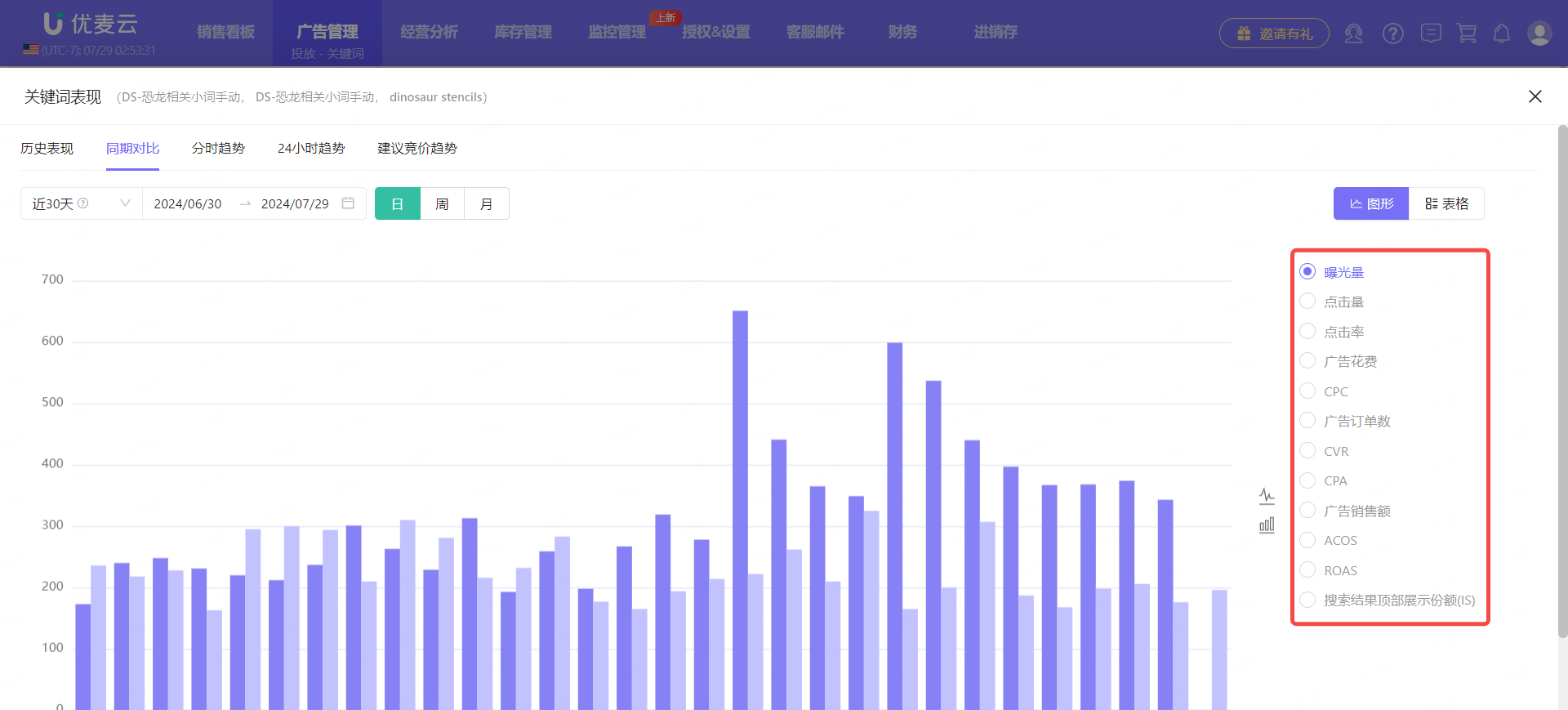 +
+
The time range for period-over-period comparison is set consistently with the query bar.
 +
+
It also supports displaying comparison data by "Day, Week, Month".
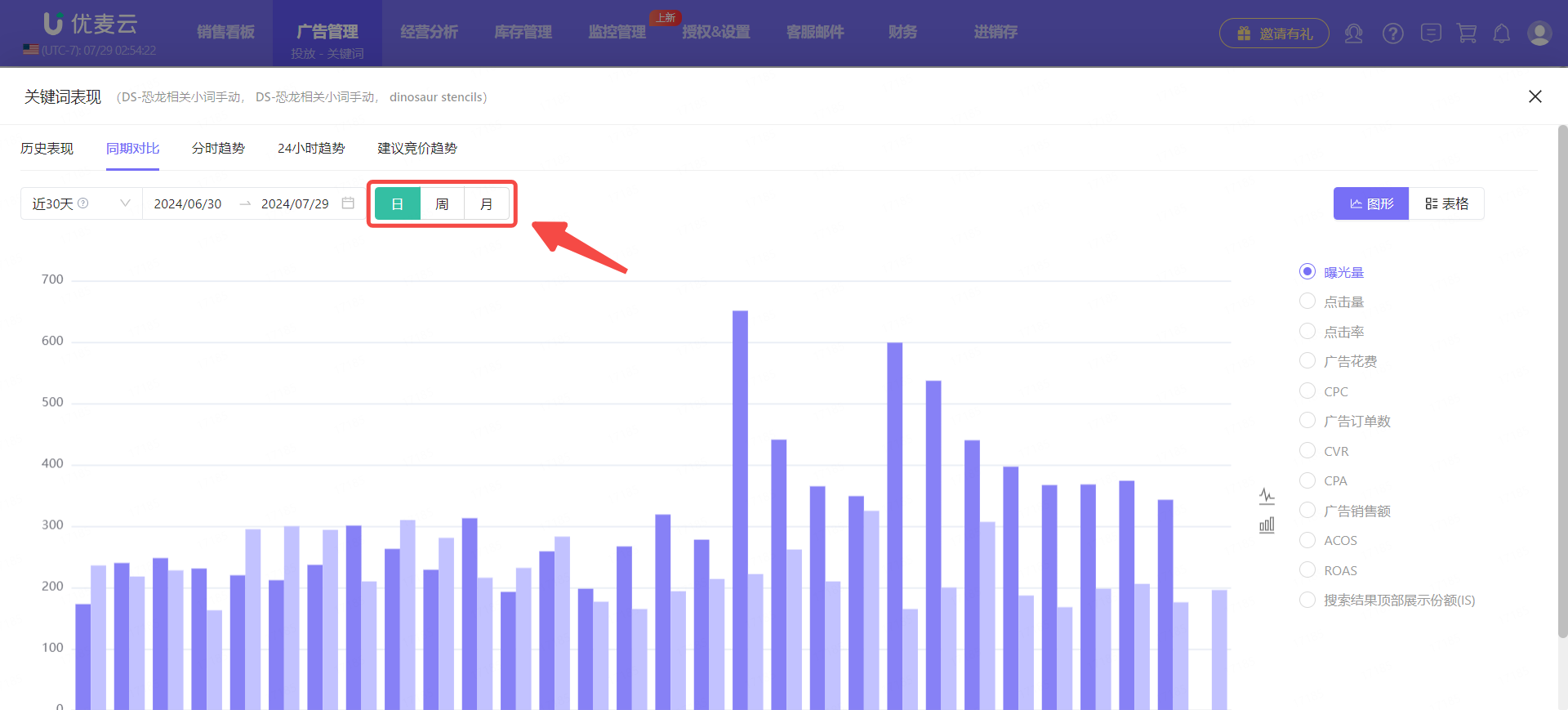 +
+
In addition to bar charts, you can also switch to line charts for viewing. Use whichever you prefer.
Click the icon button on the right to switch with one click.
 +
+
Finally, in addition to the "Chart" mode, period-over-period comparison data can also be viewed in "Table" format.
Click 【Table】 in the upper right corner to switch with one click.
 +
+
Hourly Trends
Each match type of ad keyword supports viewing its hourly targeting data for each day in the last 15 days, helping you understand the hourly trends of ad sales, ad orders, ad spend, ACOS, budget, impressions, clicks, CPC, and CVR, as well as their incremental and per-minute incremental data. Analyzing these trends helps you better optimize ad keyword targeting.
Hourly trend data comes from Amazon API data and is not statistically analyzed by the hour but based on the time point of data retrieval.
Its usage method is basically consistent with 【Total Chart】.
 +
+
Let's take "viewing yesterday's ad impressions and clicks, and their incremental hourly trends in line chart solid line format" as an example.
Click 【Set Default Display Metrics】 in the upper right corner, enter to select to only display: Impressions, Clicks, Ad Impression Increment, Click Increment, and set them to line solid line charts.
 +
+
After setting, select the data time range.
The system displays hourly trend data for the last 7 days by default. Click the time setting box in the upper left corner and select 【Yesterday】.
 +
+
After selecting, you can view yesterday's ad impression click and incremental trend data.
 +
+
In addition to the above settings, you can also set the displayed metrics individually.
- Click the eye icon to view the metric individually. Click again to restore the original state.
- Click the 【Settings】 button to set the style of the metric individually, including color and display style.
- Click the 【Delete】 button to cancel the default display of the metric.
 +
+
Supports viewing hourly trend data in 【Table】 format.
Click 【Table】 in the upper right corner to switch with one click. And supports setting metric display order.
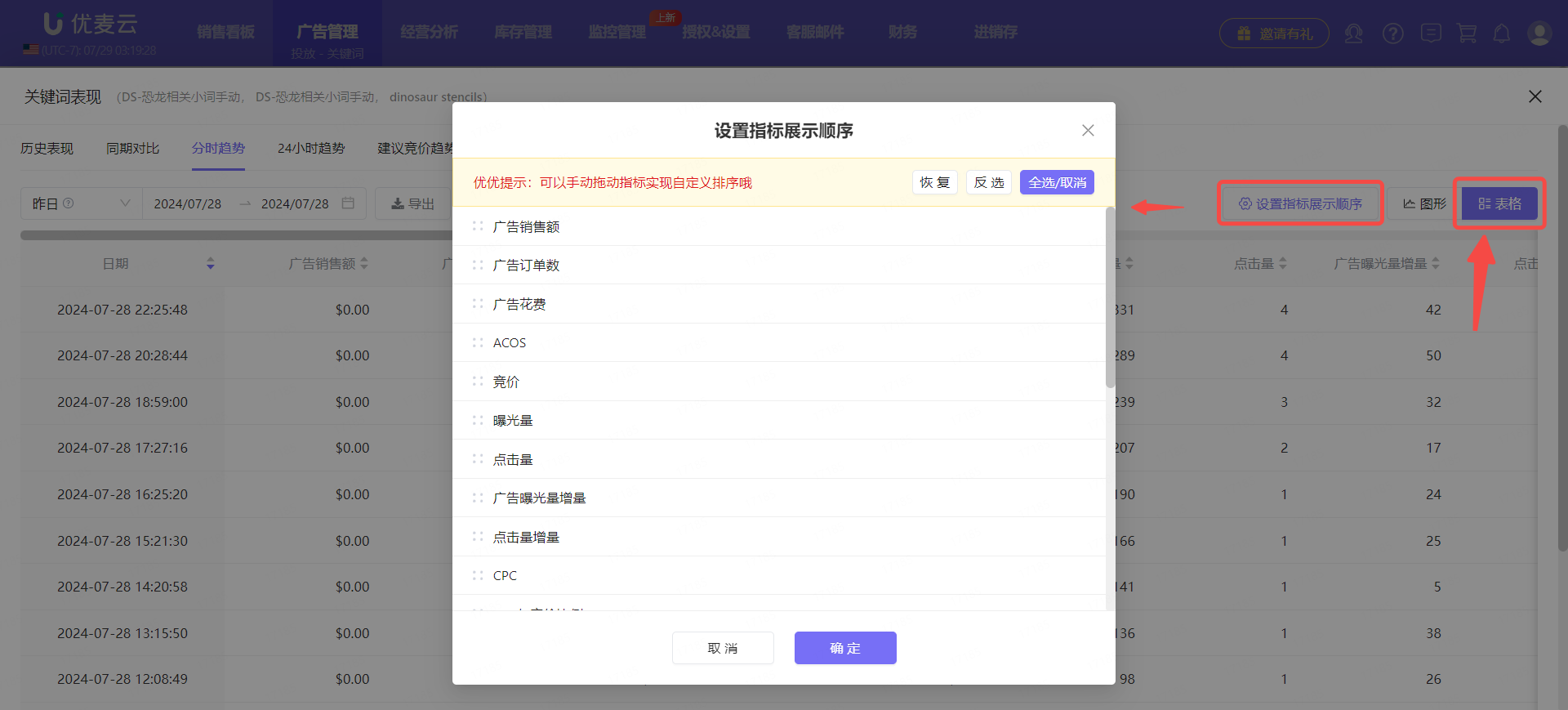 +
+
Current hourly trend data supports exporting in Excel table format.
Click 【Export】 to export with one click.
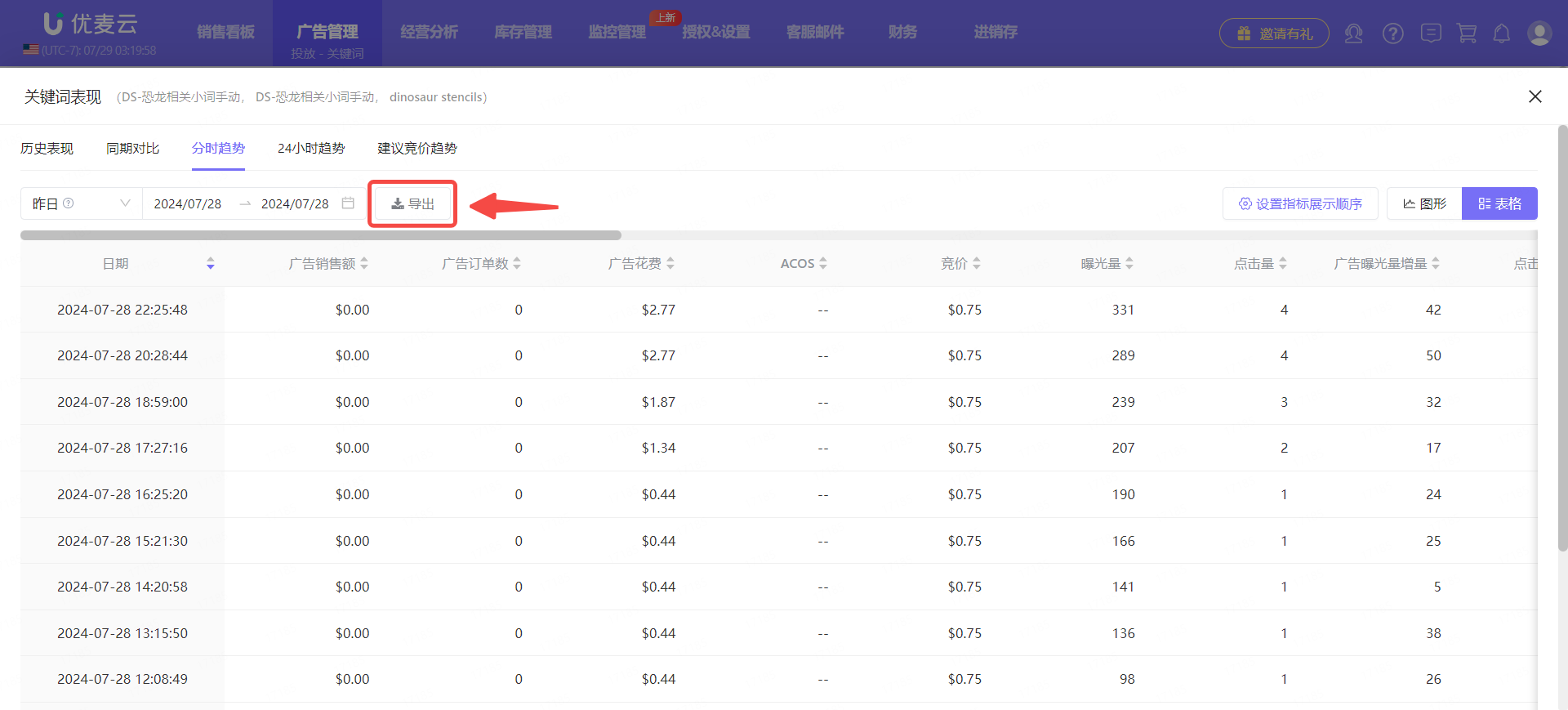 +
+
24-Hour Trends
24-hour trend data is similar in usage to 【Hourly Trends】, with only 2 differences, as follows:
- Hourly Trends: Non-hourly time data; 24-Hour Trends: 24-hour hourly ad trend data for each hour of the day.
- Hourly Trends: Can only view data for the last 15 days; 24-Hour Trends: Can view data for all synchronized time periods.
Further note: 24-hour trends can only view 24-hour hourly data for paid time periods. SB/SD ads have data after March 7th.
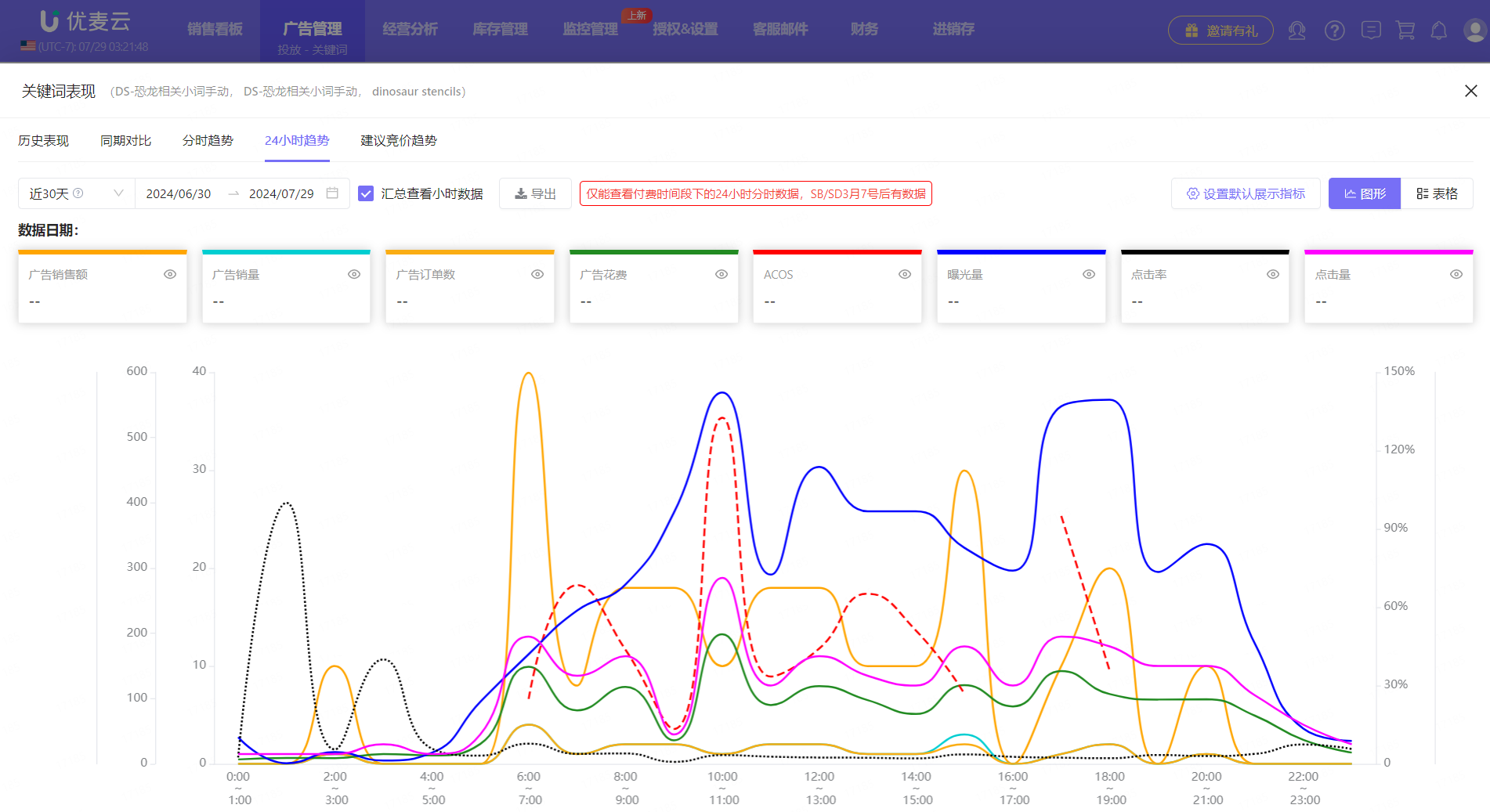 +
+
Suggested Bid Trends
Suggested Bid Trends, as the name suggests, are records of suggested bids for keywords at different time points.
This data complements the 【Hourly Suggested Bid Strategy】 feature of Scheduled Strategy, helping sellers who want to adjust directly based on suggested bids to better optimize their targeting bids.
Scheduled Strategy - Tutorial with Images and Text: Click here to view
Its usage method is similar to 【Hourly Trends】, supporting viewing suggested bids at different time points, viewing suggested bids of a specific type individually, viewing in table or chart mode, etc.
 +
+
1.11 Ad Placements
In addition to Sponsored Products (SP) and Sponsored Brands (SB) campaigns, ad placement data can also be viewed for targeted keywords.
You can directly analyze the ad placements of keyword targeting and adjust keyword bids based on ad placements to maintain favorable ad positions for targeting and gain more clicks and orders.
Ad placements include: Top of search results (page), Product pages, Rest of search results, Amazon Off-site. For the first three, you can also view the product composition under each placement and the corresponding ad performance.
However, ad placement data for keywords only supports paid users viewing data for paid time periods. There is no data for non-paid time periods.
Select the keyword you want to view, click the 【Ad Placements】 button to enter to analyze and adjust ad placement bids.
 +
+
Ad placement data displays data for the current day by default.
You can also select other times to view the corresponding ad placement performance.
 +
+
In addition to viewing placement details for the selected time period, you can also analyze the historical trends of ad placement performance.
Click the analysis button on the right of the corresponding ad placement to enter to analyze historical trends. The analysis-related operations are basically consistent with keyword 【Historical Performance】.
 +
+
Ad placement historical trend data:
 +
+
1.12 Data Comparison
When running ads for a product, you may target multiple keywords for that product, or even target multiple keywords with different match types. At this time, you need to "select the best and eliminate the worst" by comparing and analyzing their data to decide which to keep and which to discard.
The 【Data Comparison】 feature can help you compare the core performance data of different ad keywords, identify differences, and discover problems.
You can compare the targeting data of multiple keywords.
Find the keywords you want to compare, check them, and click 【Data Comparison】 to enter the comparison data pop-up page.
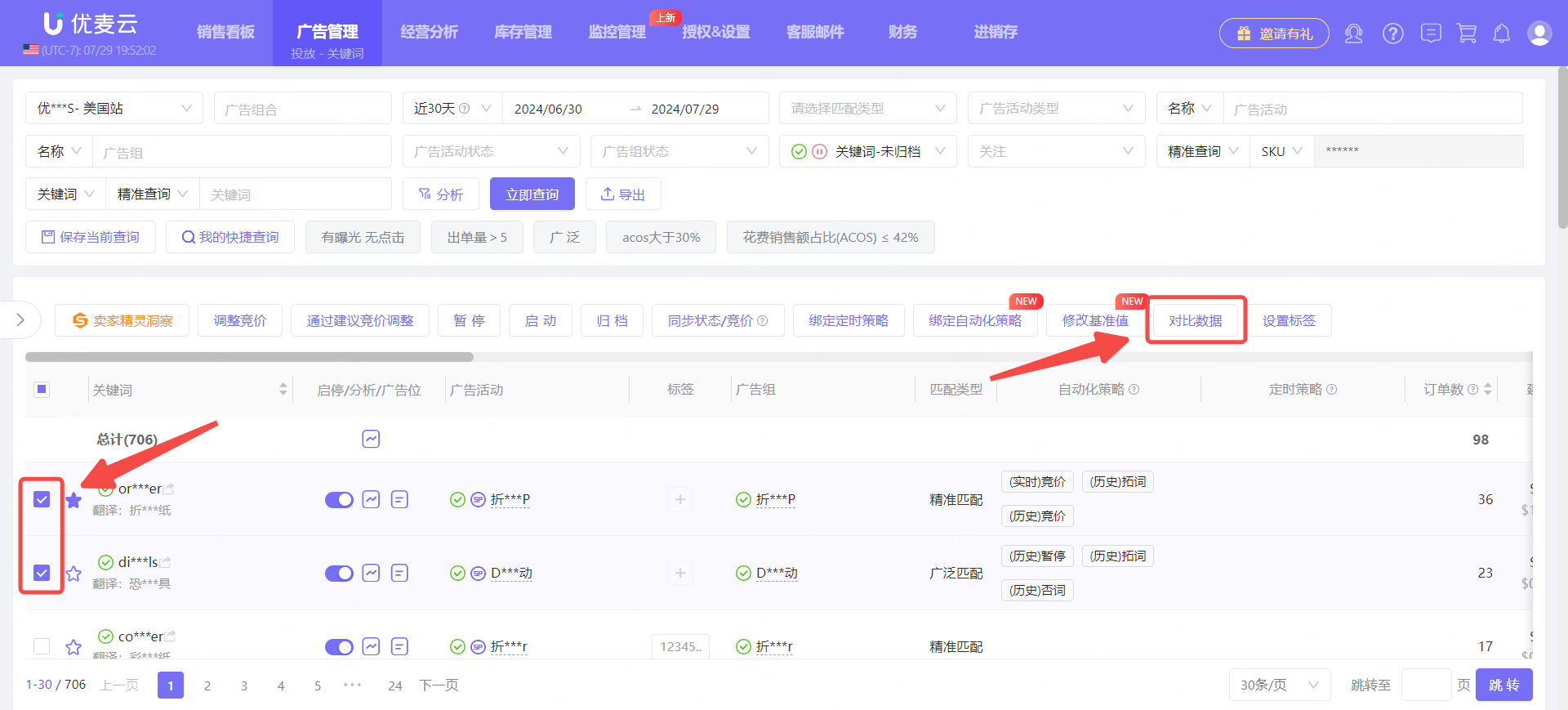 +
+
Enter the "Data Comparison" page.
First, select the metrics you want to compare and view.
Metrics for data comparison are core ad targeting metrics: ACOS, Clicks, Ad Spend, CPA, CPC, Ad Orders, Ad Sales, CTR, CVR, Impressions, ROAS.
 +
+
Then, select the data time range.
You can compare and analyze keyword data for all time periods synchronized since authorization.
Click the time bar, select the corresponding time range, and customize it. At the same time, based on the length of the selected time range, you can further choose to display data by "Day, Week, Month".
 +
+
After selecting the data time range and metrics, you can directly view the corresponding data.
Hover your mouse over the line chart to view the specific data of the nodes.
 +
+
Hover your mouse over the keyword name above to view the corresponding metric performance trend of that keyword individually.
 +
+
Click the campaign name to hide the data of that campaign. Click again to restore display.
 +
+
In addition to line charts, you can also view and analyze comparison data in bar chart format.
Click the chart mode on the right to switch with one click.
 +
+
1.13 Quick Jump
Keyword data is not displayed in isolation. It is linked with advertising data in other dimensions. For example, after analyzing keyword data, if you want to further see which campaign and Ad group it belongs to, what the corresponding promoted product is, how many search terms it matches, etc., you can quickly jump to the corresponding ad module to directly view and analyze the corresponding data.
① Belonging Campaign and Ad group
Click "Campaign Name" or "Ad group Name" to jump to view the data of that campaign and Ad group.
 +
+
② Corresponding Promoted Product
 +
+
③ Matched User Search Terms
 +
+
1.14 Tree Navigation
This feature is mainly for sellers who are familiar with Seller Central and are new to SellerSpace. To help these users quickly familiarize themselves with and get started with SellerSpace, SellerSpace launched the 【Tree Navigation List】, which aligns with the ad display format of Seller Central, making the ad structure clear at a glance!
Click the button on the left to open or collapse the tree navigation feature.
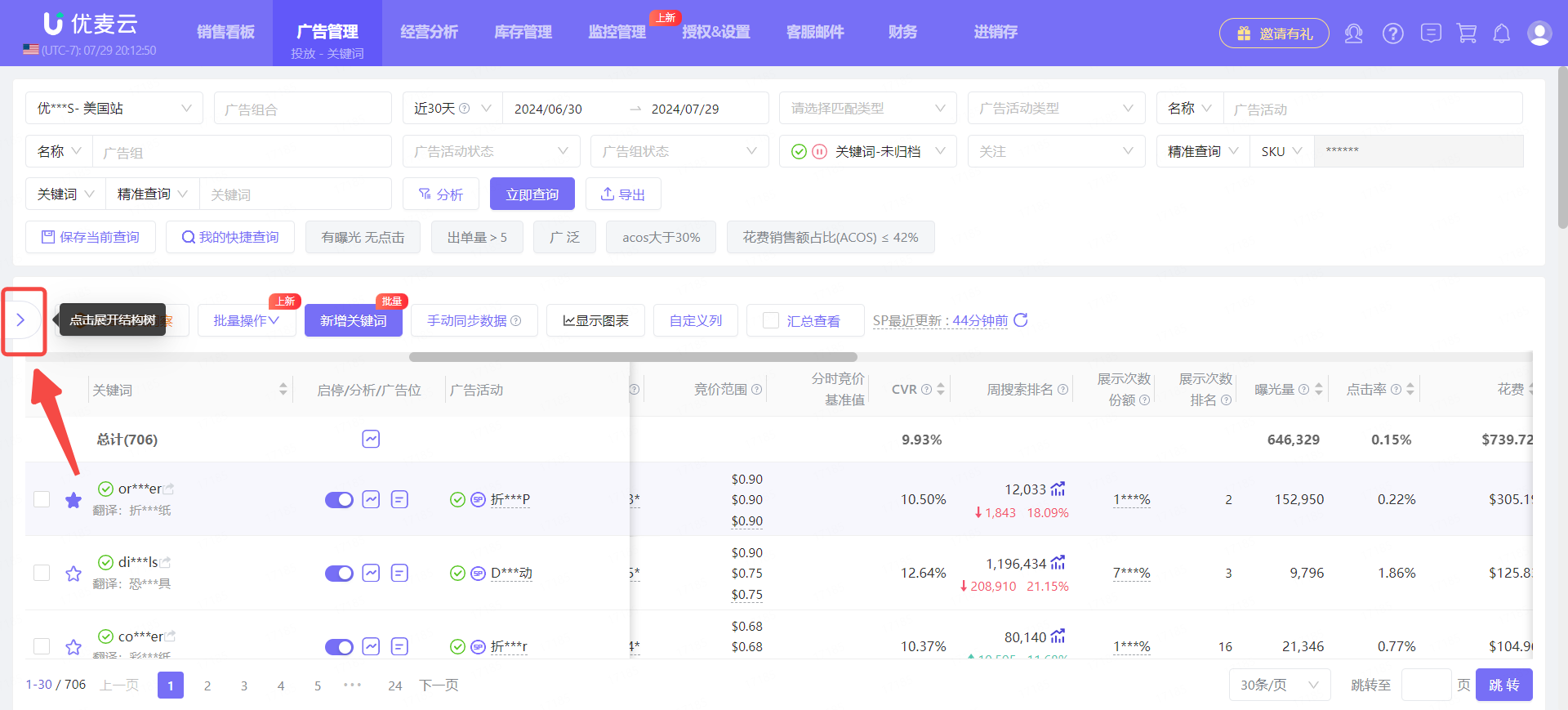 +
+
Click the plus sign "+" to expand the next level of ad categories and view corresponding ad targeting data.
Click the minus sign "-" to collapse the ad object.
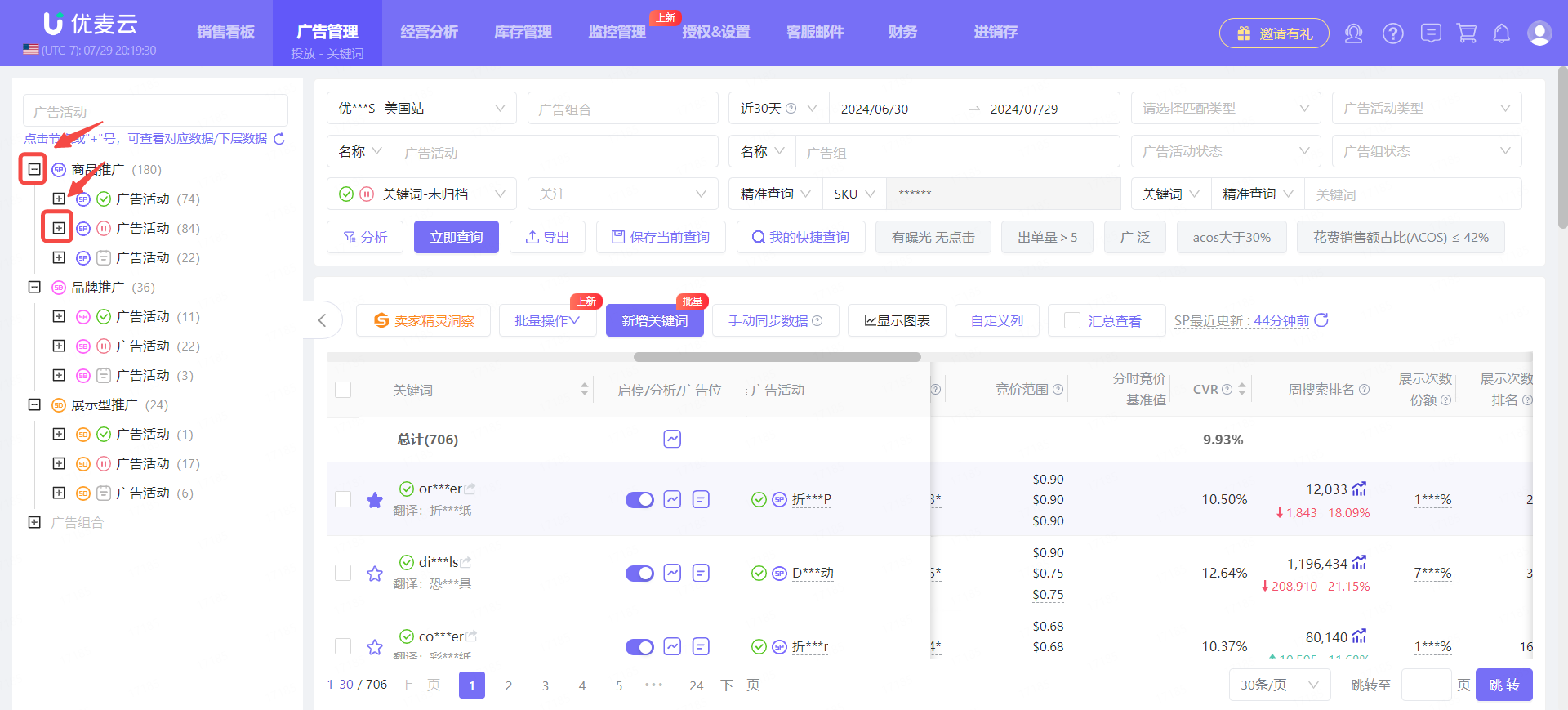 +
+
Click the node name to directly view the detailed data of the ad.
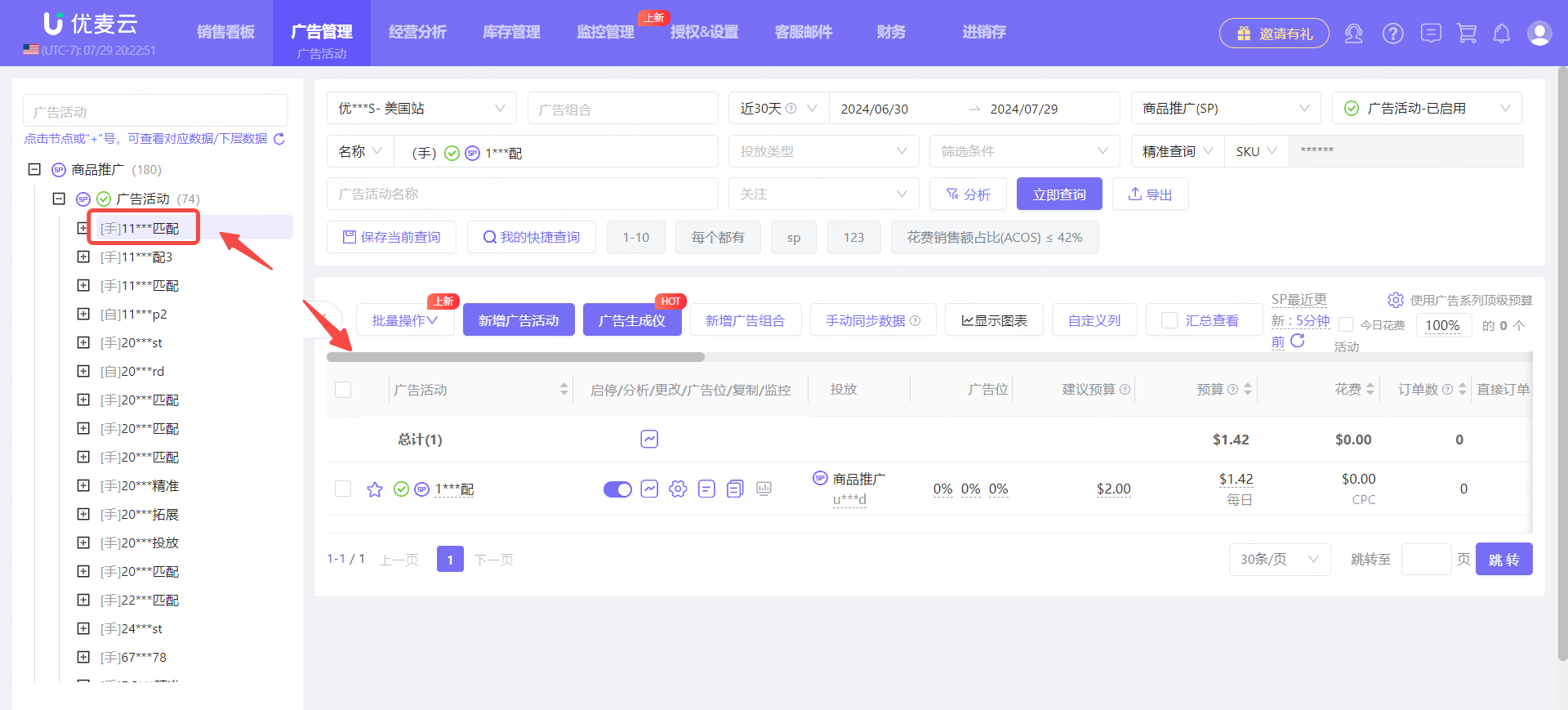 +
+
2. Adjusting Keyword Targeting
SellerSpace's advertising system not only allows direct analysis of all keyword targeting data but also supports direct adjustment of keyword targeting settings, such as bids, Enable/Pause status, etc. Adjusted data is synchronized to Amazon Seller Central in real-time, ensuring safety and reliability.
2.1 Adjusting Bids
Keyword bid adjustments include 2 types: keyword bid + placement bid multipliers (campaign level).
① Keyword Bid Adjustments
Keyword bid adjustments include 2 methods: individual adjustment + bulk adjustment.
Individual Bid Adjustment:
You can adjust the bid of a single keyword individually.
Find the keyword you want to adjust, click the bid value to enter adjustment.
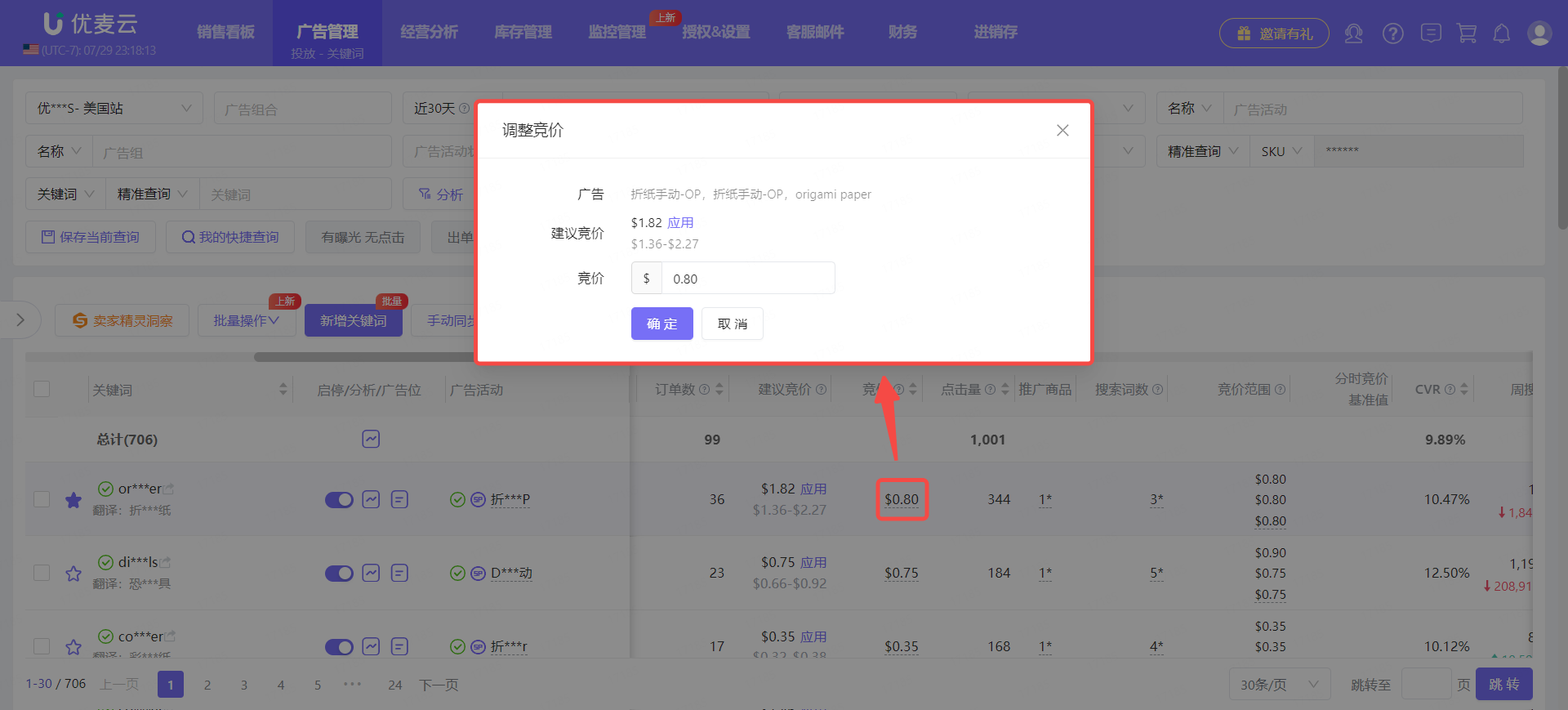 +
+
In addition to manually entering bids, you can also directly apply Amazon's Suggested Bid.
Click 【Apply】 to apply directly without confirmation.
 +
+
Bulk Bid Adjustment:
If the bid adjustment amounts for multiple keywords are similar, i.e., all reduce by \$1 or increase bids by 5%, you can directly adjust their bids in bulk.
Bulk keyword bid adjustment also has 2 methods: direct adjustment + adjustment by Suggested Bid.
Direct Adjustment:
Check the keywords for which you want to uniformly adjust bids, then select 【Adjust Bids】 to enter the "Bulk Bid Adjustment" page. Based on your needs, choose to adjust bids by "Fixed Value/Percentage Increase or Decrease/Fixed Value Increase or Decrease" and save.
 +
+
Adjustment by Suggested Bid:
Check the keywords for which you want to uniformly adjust bids, then select 【Adjust by Suggested Bid】 to enter the "Bulk Adjustment by Suggested Bid" page. Based on your needs, choose to adjust directly by Suggested Bid/by Lowest Suggested Bid/by Highest Suggested Bid, and then save.
 +
+
② Ad Placement Bid Multiplier Adjustments
Targeted keywords support viewing corresponding ad placement data, but ad placement adjustments only support adjusting ad placement bid multipliers at the corresponding campaign level. When you have analyzed the ad placement performance of keywords and want to adjust their placement bid multipliers, you can directly adjust the ad placement bid multipliers of the corresponding campaigns in the 【Targeting - Keywords】 feature.
Find the corresponding keyword for which you want to adjust the placement bid multiplier, hover your mouse over the 【Bid Range】 value to enter to modify the campaign's placement bid multipliers.
 +
+
2.2 Adjusting Enable/Pause Status and Archiving
Similar to Seller Central, we also support enabling, pausing, and archiving targeted keywords.
Operations for "Enable" and "Pause" include 2 methods: individual operation + bulk operation, while "Archive" only supports bulk operation.
① Individual Operation
Find the keyword you want to enable or pause, click the Enable/Pause button to enable or pause with one click.
 +
+
② Bulk Operation
Check the keywords you want to bulk Enable/Pause or archive, click the corresponding Enable/Pause or archive button, and then save.
 +
+
2.3 Adding New Keyword Targeting
In addition to analyzing and adjusting existing keyword targeting, we also support adding new keywords for campaigns and Ad groups for targeting. You can also directly add negative keywords. New data is synchronized to Amazon Seller Central in real-time.
Click 【Add Keywords】 to enter the adding page.
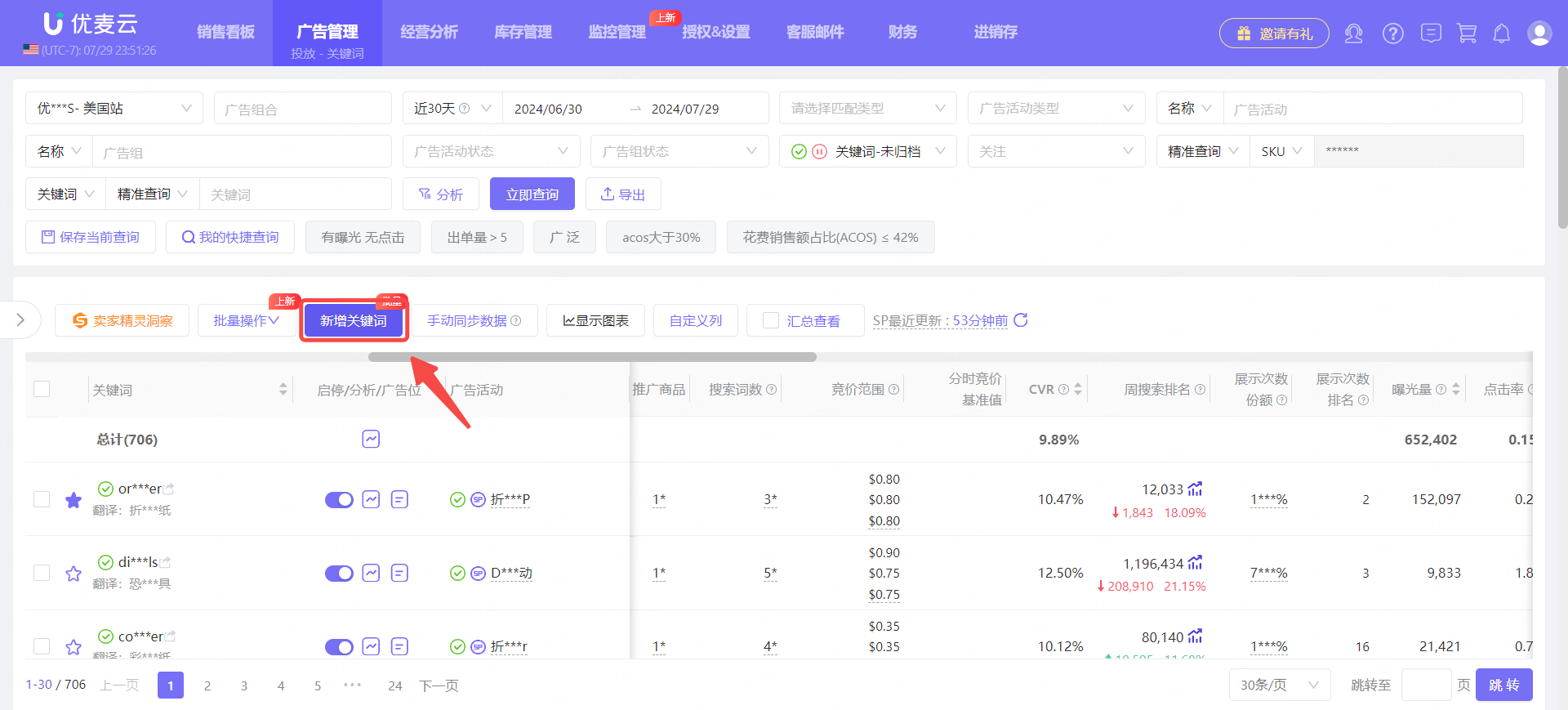 +
+
Enter the "Add Keywords" page.
First, you need to select 【Adding Method】.
There are 2 adding methods: Add new keyword targeting under a specified Ad group + Bulk add new keyword targeting under multiple specified Ad groups.
As the names suggest, the following operations will be slightly different depending on the method. Let's look at them one by one.
 +
+
① Add New Keyword Targeting Under a Specified Ad group
Select "Add new keyword targeting under a specified Ad group", then select the corresponding campaign and Ad group.
After selecting, the corresponding targeting settings data will be automatically expanded.
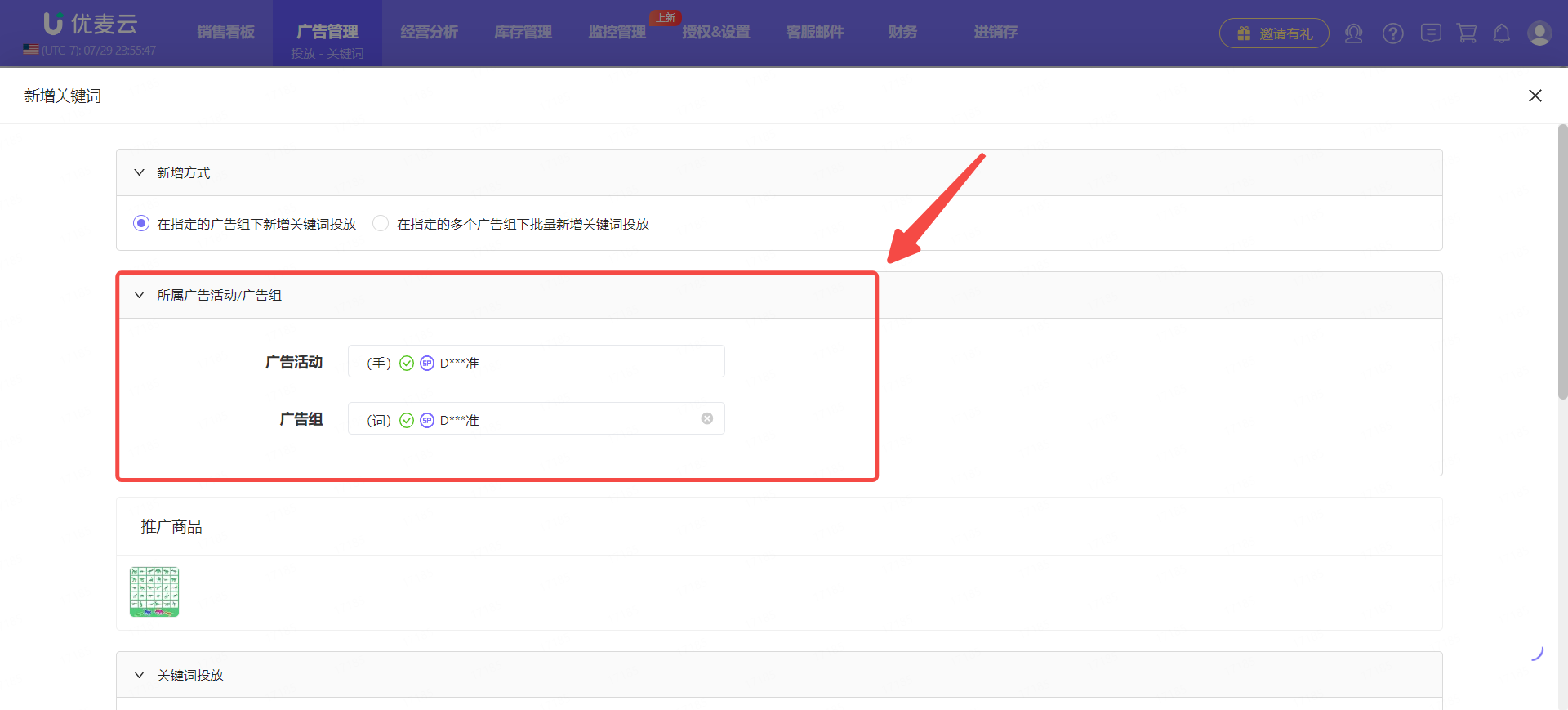 +
+
Then, add corresponding keywords for targeting.
Go to the 【Keyword Targeting】 section and add corresponding keywords according to your needs.
The adding method is consistent with adding keywords when creating campaigns. Ad Campaigns - Tutorial with Images and Text: Click here to view
 +
+
Among them, there is a linked feature: SellerSpirit Insight. When we filter Amazon Suggested Keywords, we can directly use the SellerSpirit Insight feature to link with 【Keyword Research】 to view the relevance, competitiveness, search volume, and purchase volume of the keyword in the Amazon marketplace, helping us decide whether it is worth targeting the keyword.
For specific usage, see: 3.1 SellerSpirit Insight
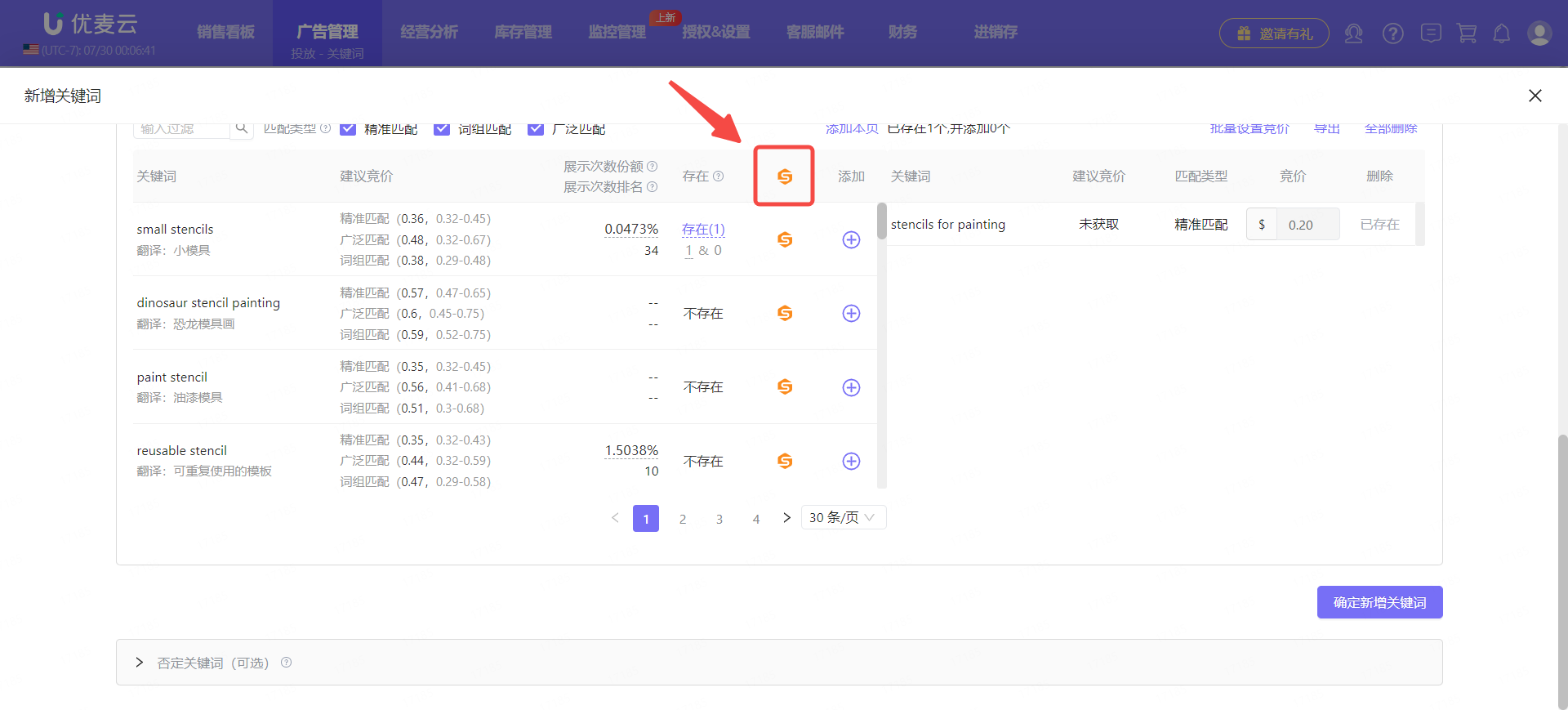 +
+
Finally, confirm that all information is correct and click 【Confirm Add Keywords】 to save.
 +
+
Last but not least, there is an optional setting: Negative Keywords.
If you happen to have negative targeting needs, you can also directly add negative keywords here.
Click 【Negative Keywords (Optional)】 to expand the settings page.
 +
+
The adding method for negative keywords is consistent with that when adding new campaigns.
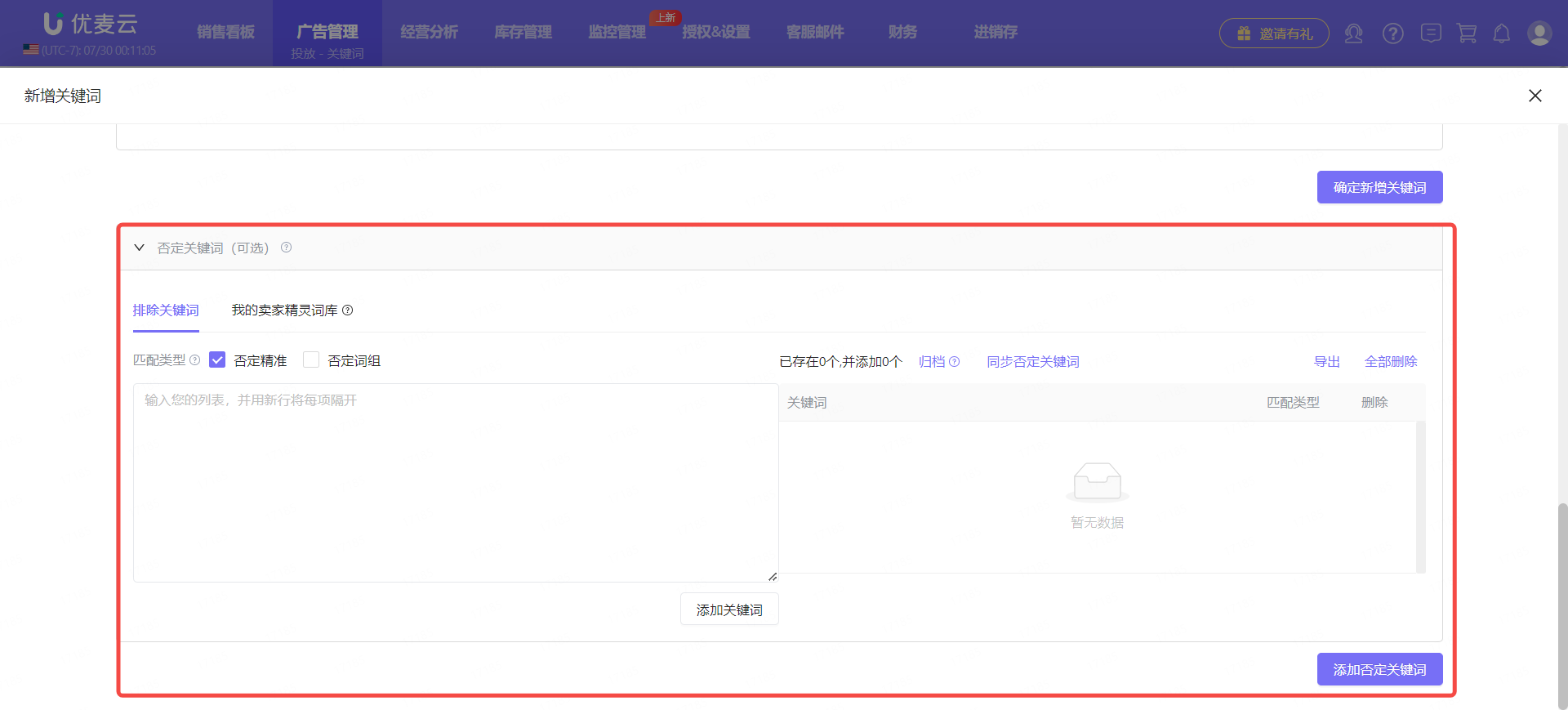 +
+
② Bulk Add New Keyword Targeting Under Multiple Specified Ad groups
Select "Bulk add new keyword targeting under multiple specified Ad groups", then select the corresponding campaigns and Ad groups.
After selecting, the corresponding targeting settings data will be automatically expanded.
 +
+
Then, add the keywords to be targeted.
Different from specifying a single Ad group, bulk adding under multiple specified Ad groups only supports manual bulk input or bulk adding keywords from your SellerSpirit keyword library.
 +
+
Finally, select the Ad groups to which you want to add the selected keywords and set bids.
Filter out the Ad groups to which you want to add keywords and set corresponding bids for the keywords, and then save.
 +
+
3. Feature Integration
The Targeting - Keywords feature is closely related to our other ad enhancement tools and can be integrated and combined to further improve seller ad efficiency and effectiveness.
3.1 SellerSpirit Insight
This is an integration feature with SellerSpirit. When you add new ad targeting or analyze ad data in SellerSpace, you can directly use SellerSpace to gain insights into the market relevance, competitiveness, search and purchase volume, etc., of user search terms, Amazon Suggested Keywords, and targeted keywords, facilitating quick decisions on whether to target or negate.
The SellerSpirit Insight feature is mainly distributed in the 【Targeting - Keywords】, 【Search Terms】 features, and "Amazon Suggested Keywords" when adding keywords.
Let's take the usage of 【SellerSpirit Insight】 in the 【Targeting - Keywords】 feature as an example.
Enter the "Targeting - Keywords" feature homepage, find the keyword you want to gain insight into, and click 【SellerSpirit Insight】 to enter the data page.
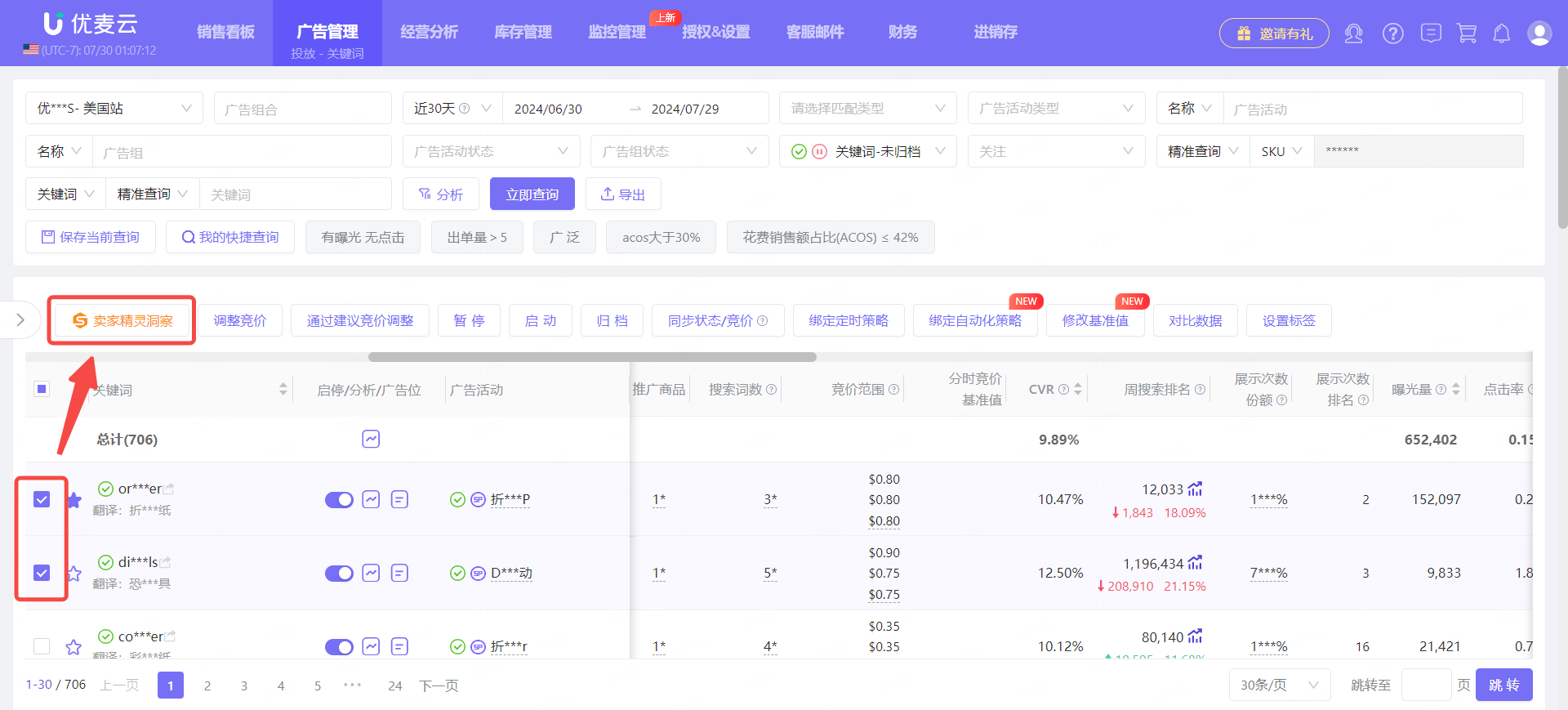 +
+
Enter the "Bulk Keyword Insight via SellerSpirit" page.
The system displays insight data for the last 30 days by default. You can also choose other months to view and analyze.
Note: Some keywords may not be displayed due to low ranking and not being included.
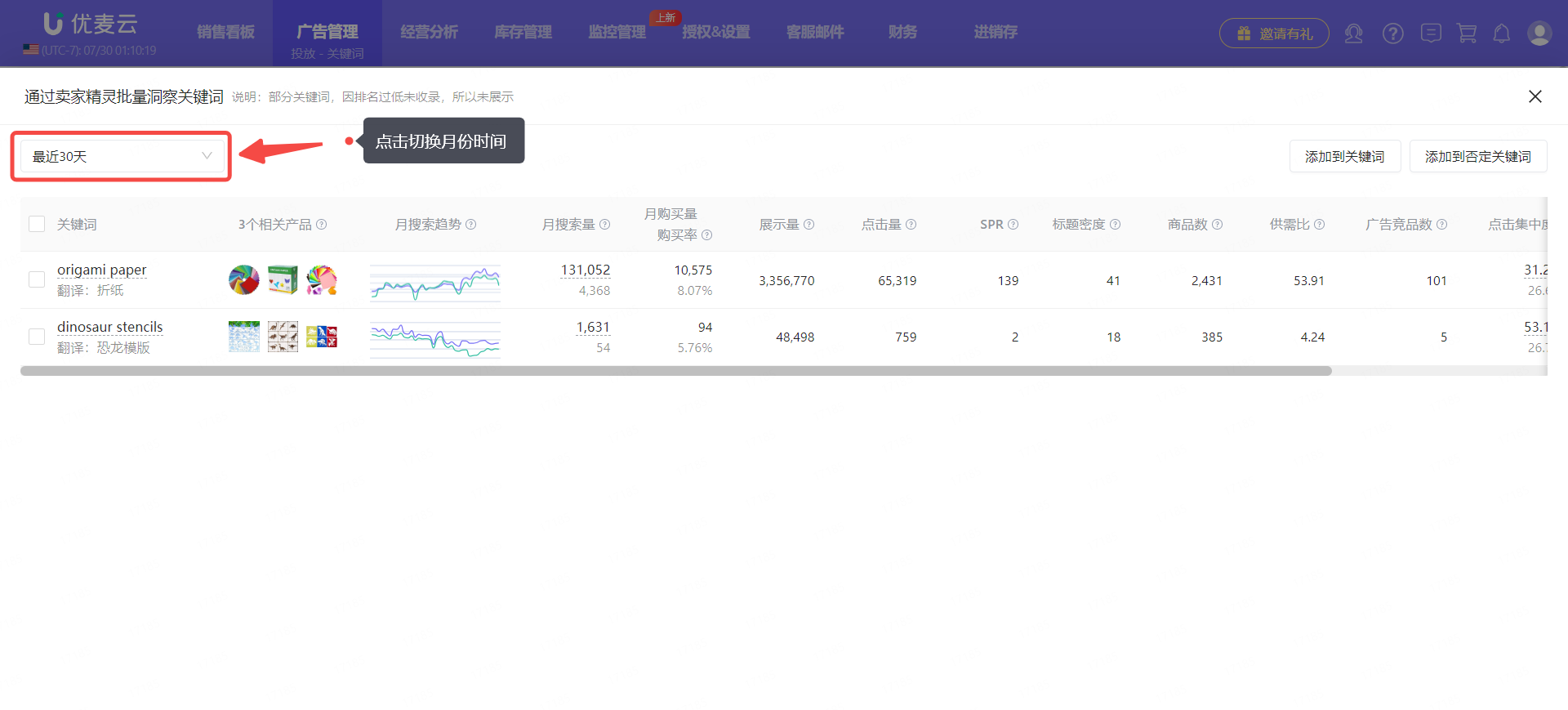 +
+
Among them, for "Monthly Search Trend" data, hover your mouse over the corresponding line segment to view the specific data of the node.
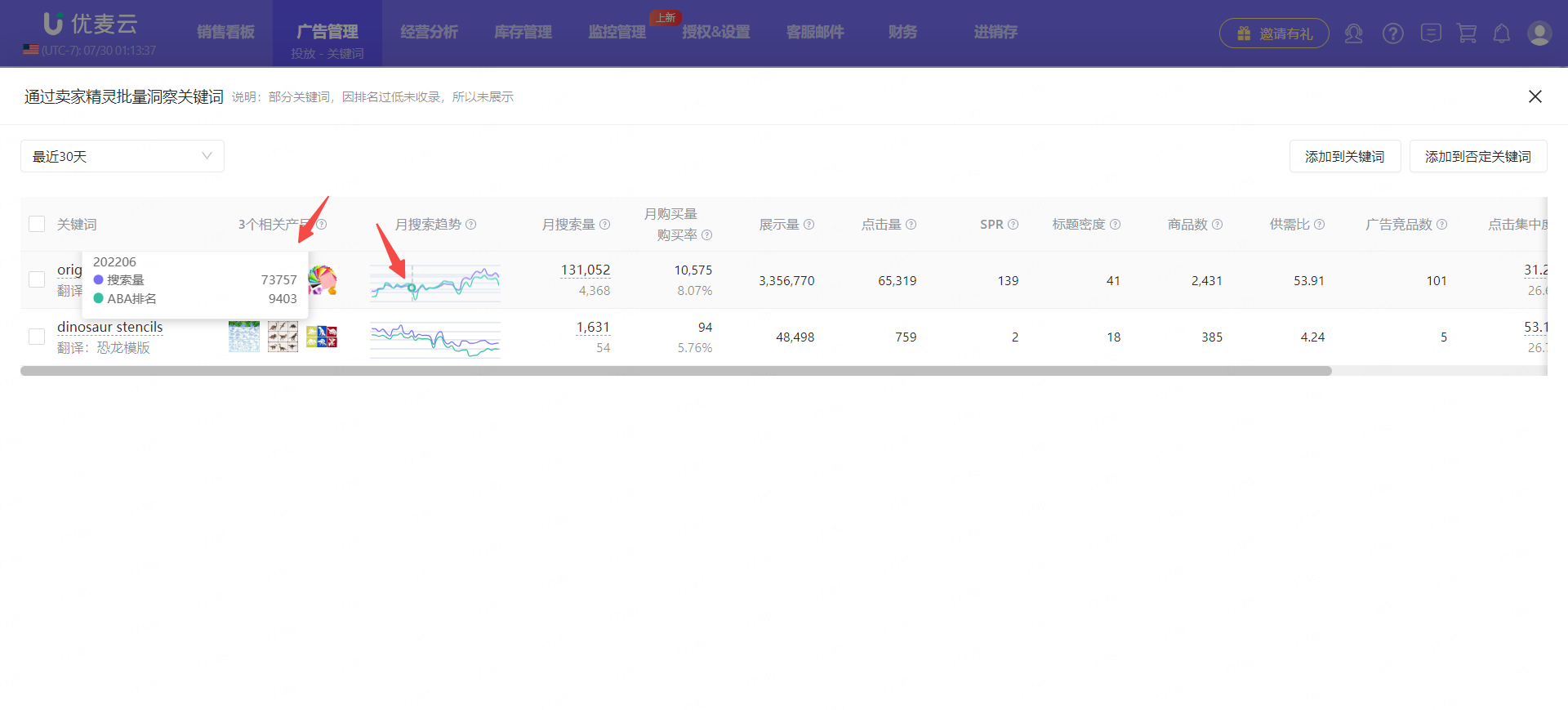 +
+
Click the "Monthly Search Volume" value to view the monthly search volume trend of the keyword, including: Search Trend, Google Trends, Click Concentration, and PPC Bids, a total of 4 types of trend data, helping us understand the overall market performance of keywords more deeply.
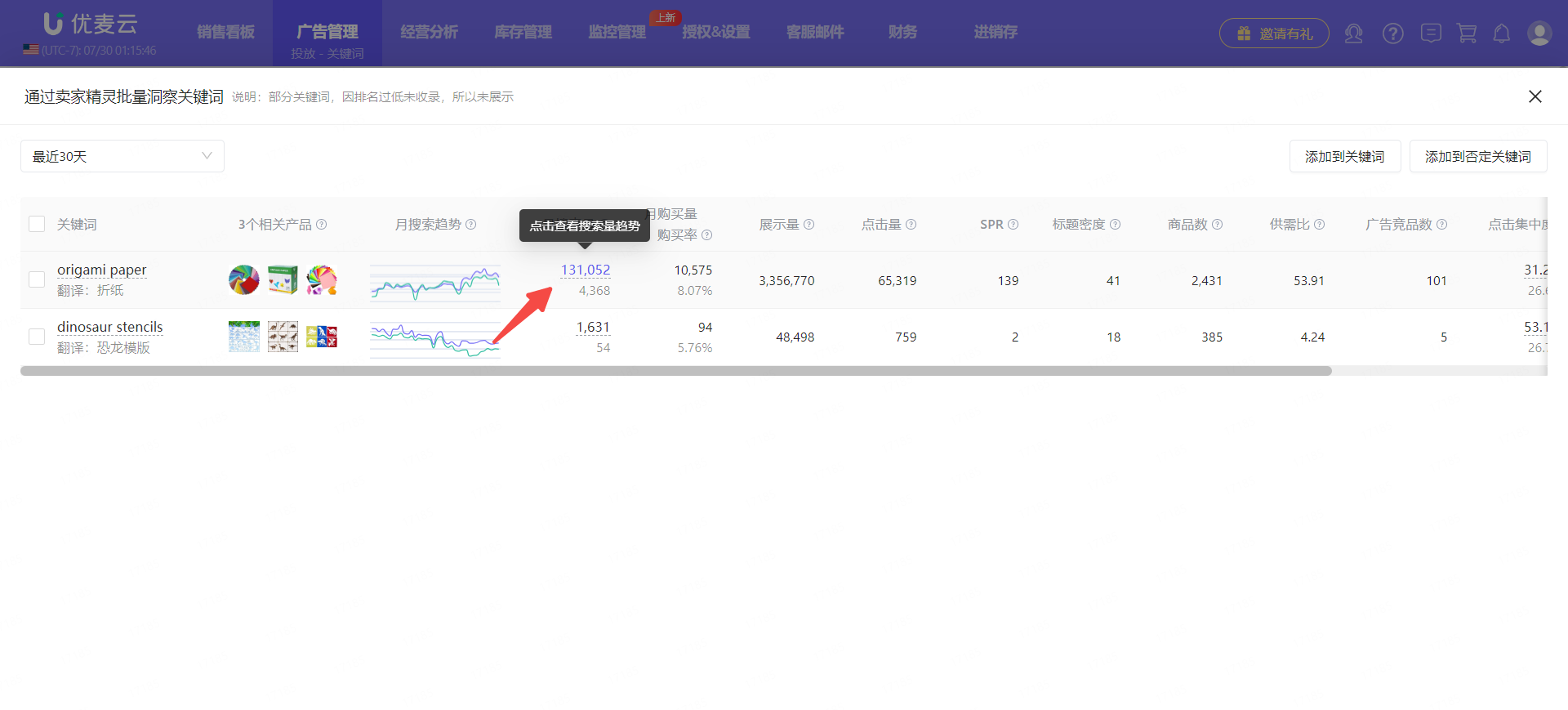 +
+
The viewing and analysis methods for the four types of trend data are basically consistent with all tables.
Search Trend:
 +
+
Google Trends:
 +
+
Click Concentration:
 +
+
PPC Bids:
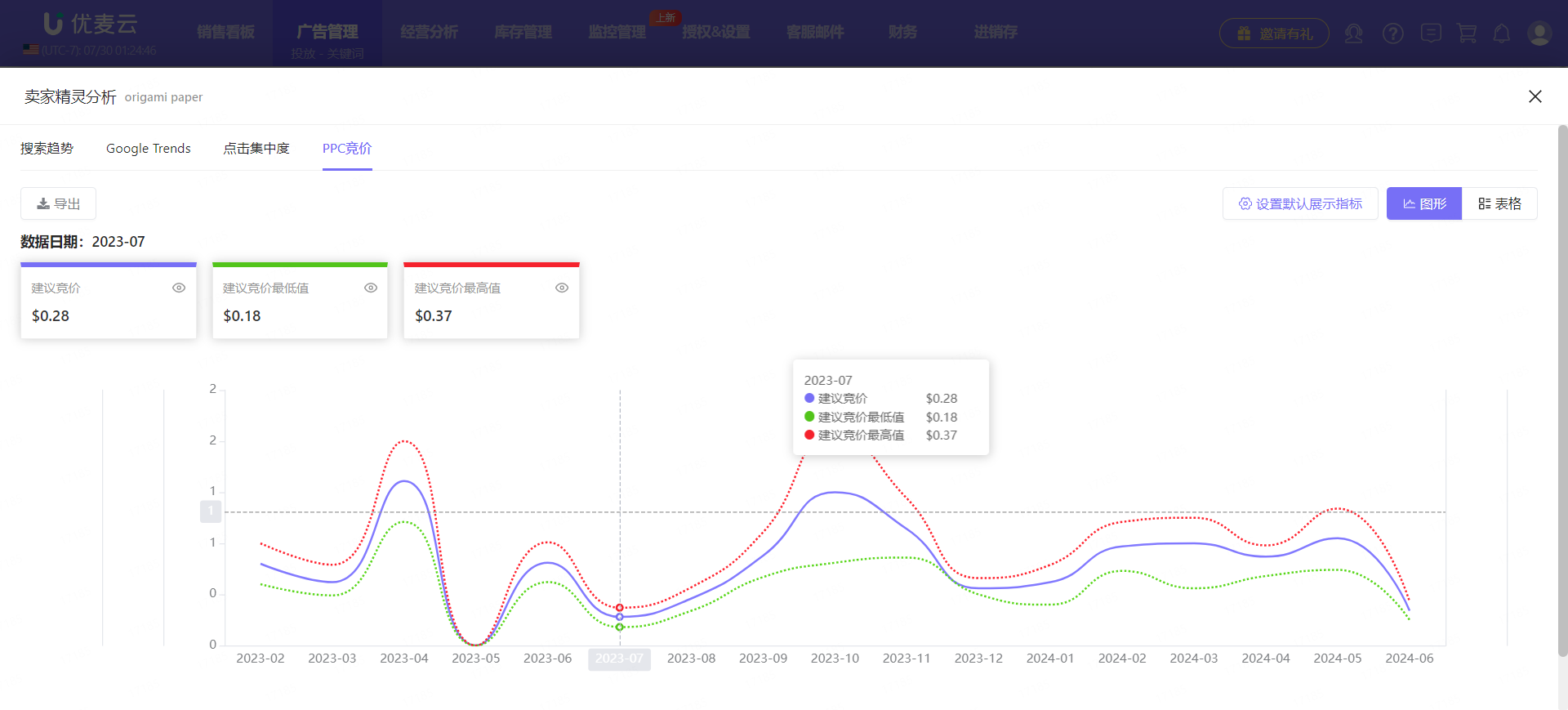 +
+
After analyzing keyword data, you can add keywords to different Ad groups for targeting or negate them directly.
Check the keywords you want to add, then click 【Add to Keywords】 or 【Add to Negative Keywords】. According to your needs, select the corresponding campaign Ad group to add.
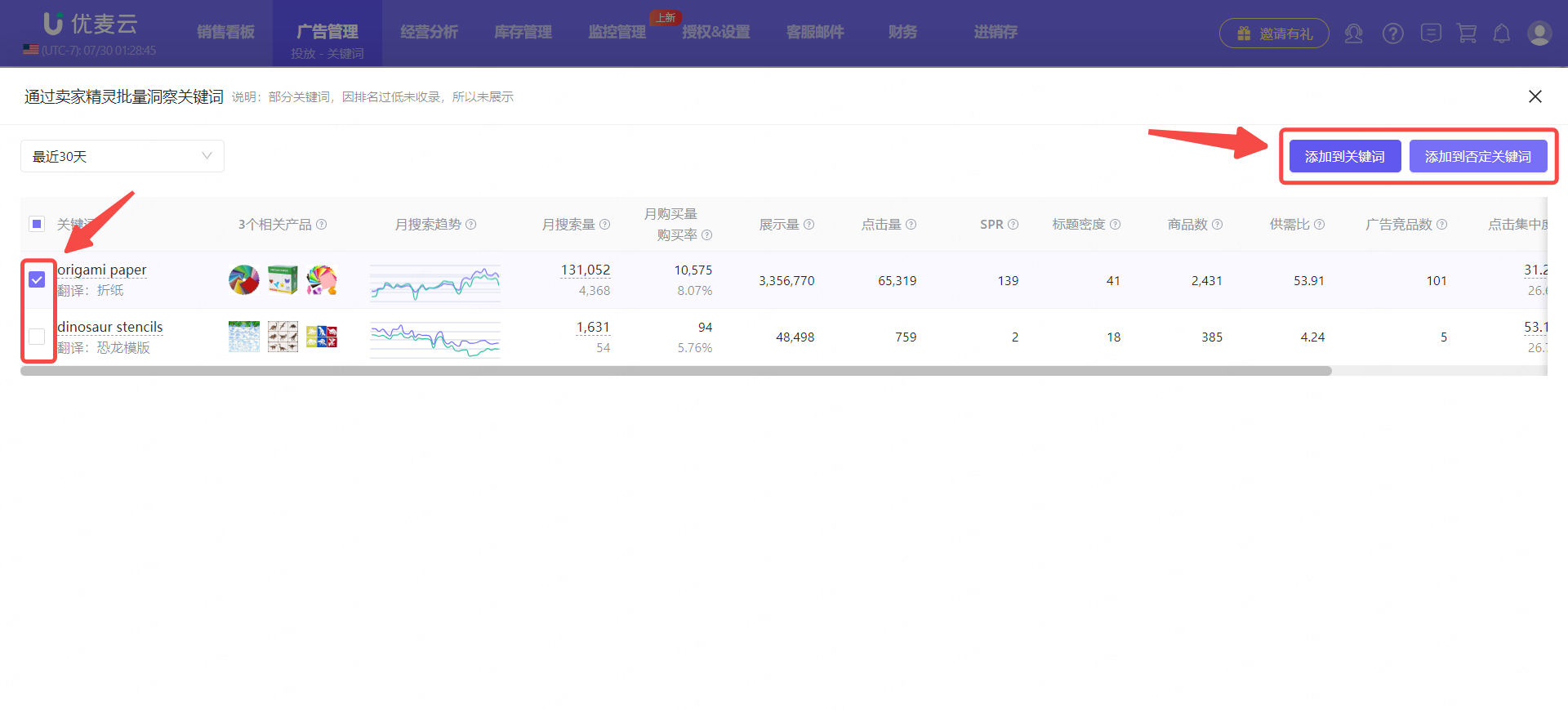 +
+
Search Terms - SellerSpirit Insight:
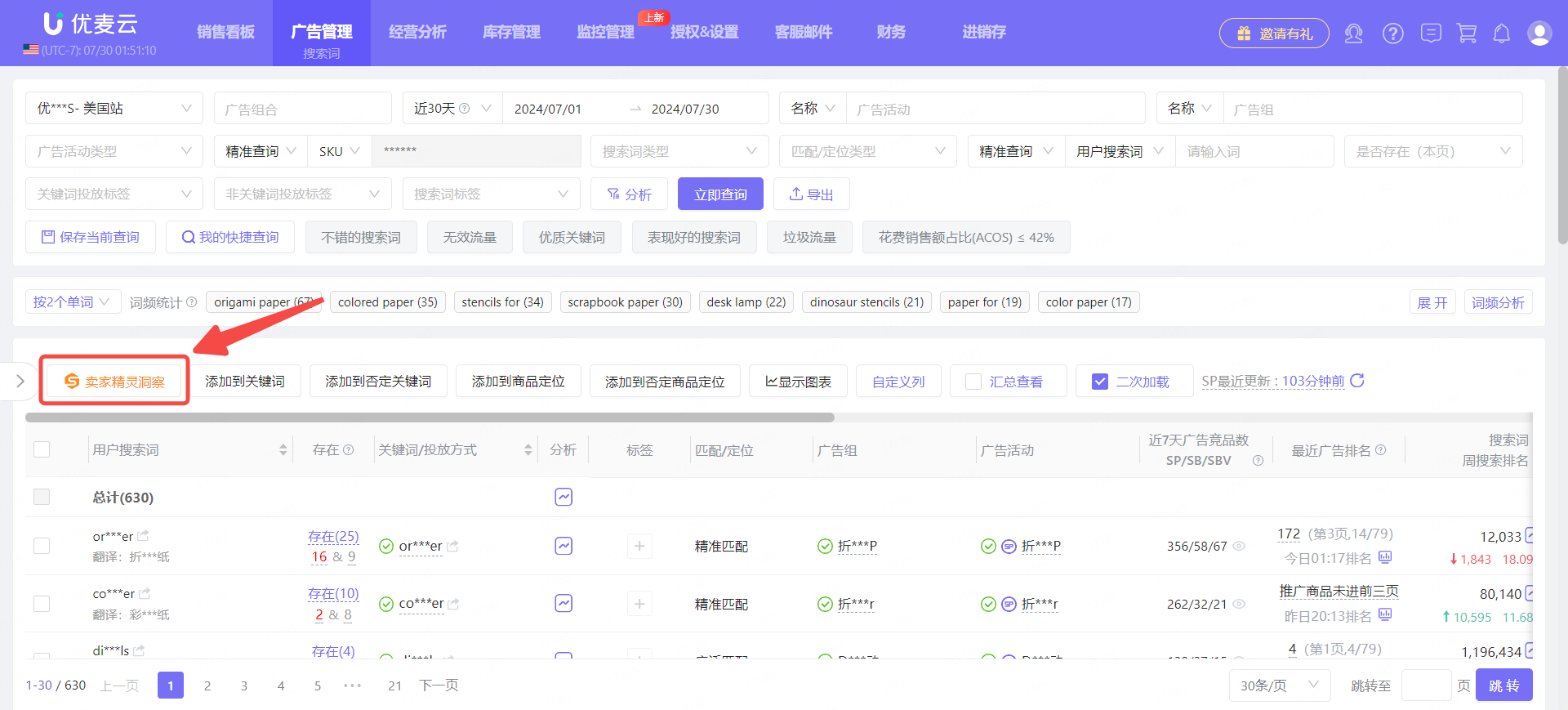 +
+
“Amazon Suggested Keywords” when adding keywords - SellerSpirit Insight:
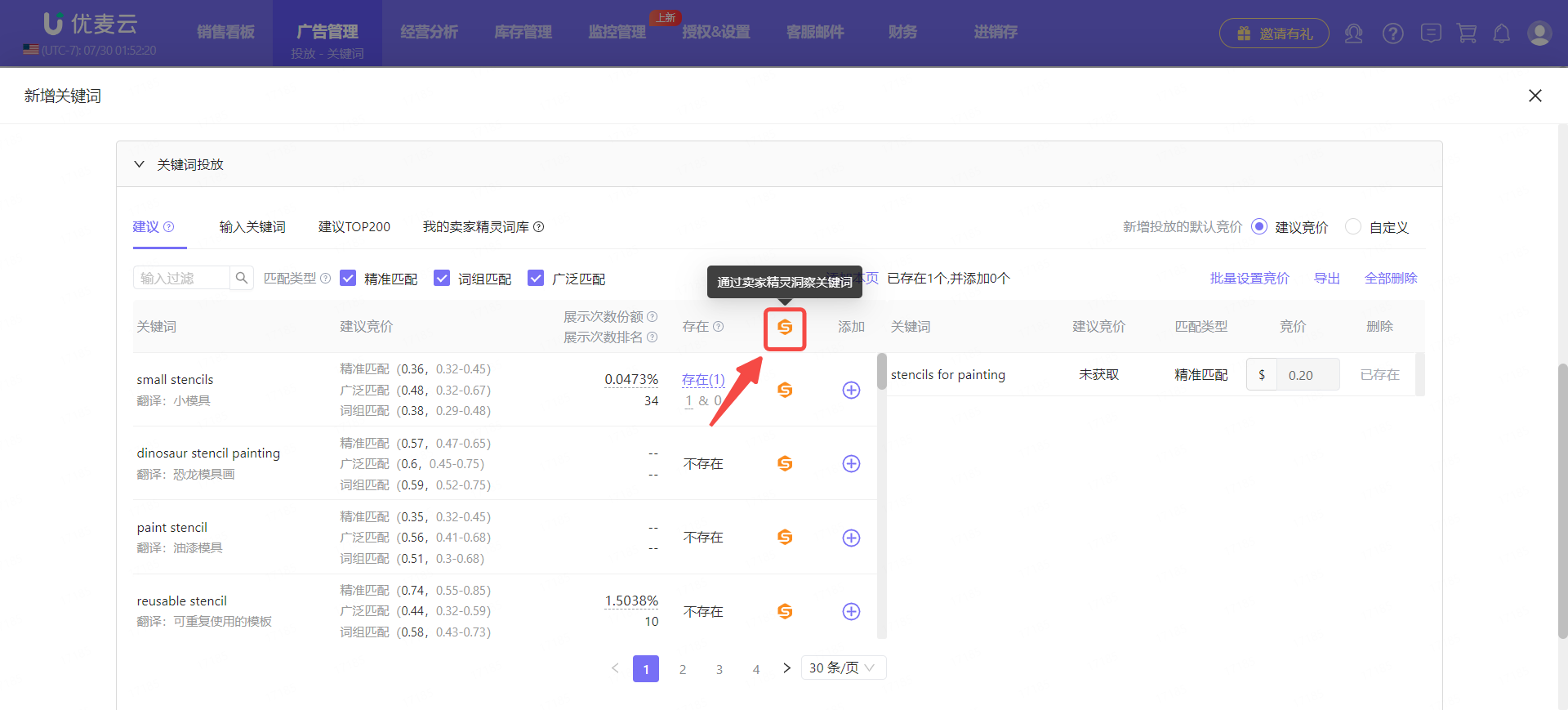 +
+
3.2 Scheduled Strategy
SellerSpace's 【Scheduled Strategy】 feature can help you automatically adjust ad targeting by time segment to maximize ad investment efficiency.
Scheduled Strategy includes five strategies: Bid Strategy, Budget Strategy, Budget Cap Strategy, Placement Bid Adjustment Strategy, and Enable/Pause Strategy. Starting from five aspects: bid, budget, budget cap, ad placement, and Enable/Pause, it refines ad targeting in all aspects.
Among them, all scheduled adjustment strategies related to targeted keywords can be viewed and unbound (operation method is consistent with Automation Strategy) on the 【Targeting - Keywords】 page.
Find the keyword bound to a Scheduled Strategy, hover your mouse over the strategy name to view the status details of the Automation Strategy.
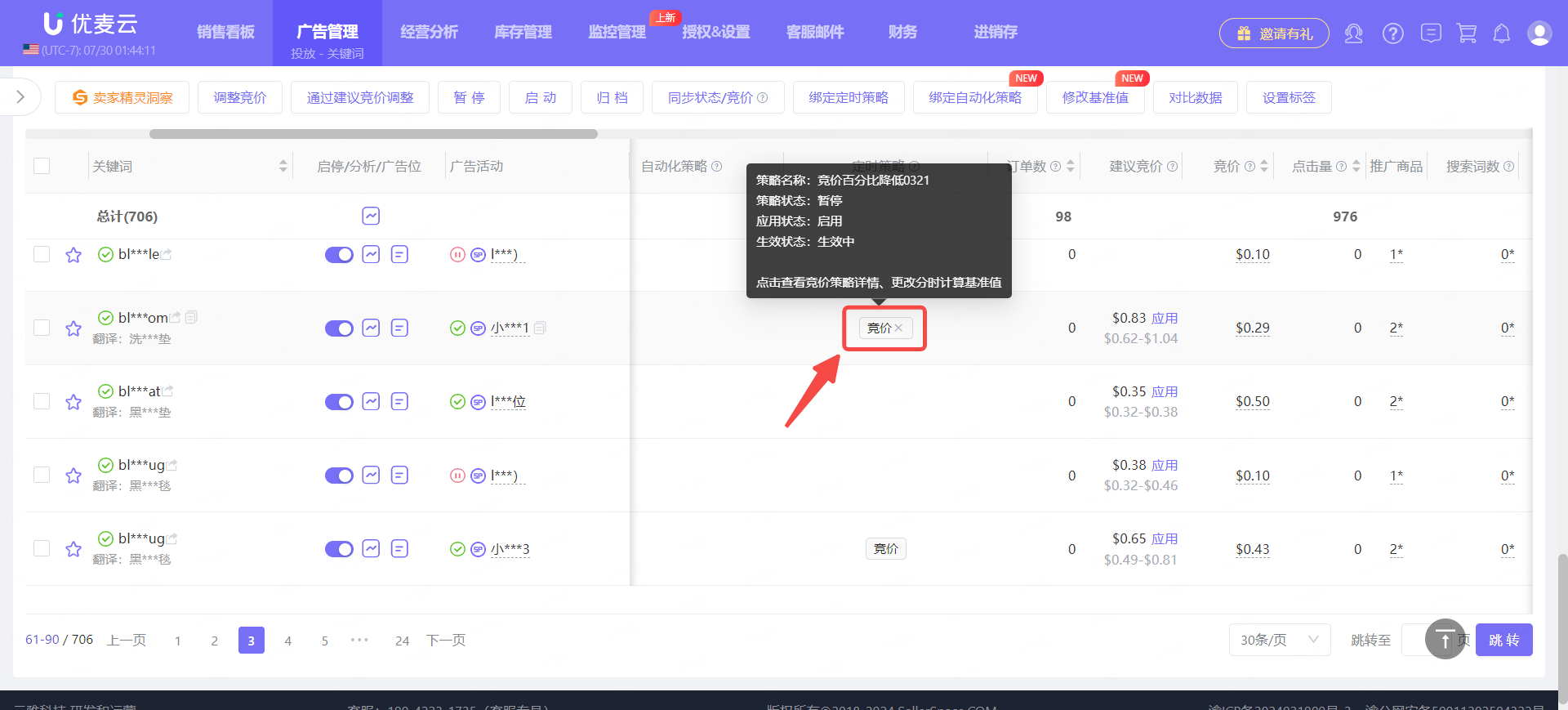 +
+
Click the strategy name to enter to view the setting details of the strategy. For example, when it will be automatically adjusted, etc.
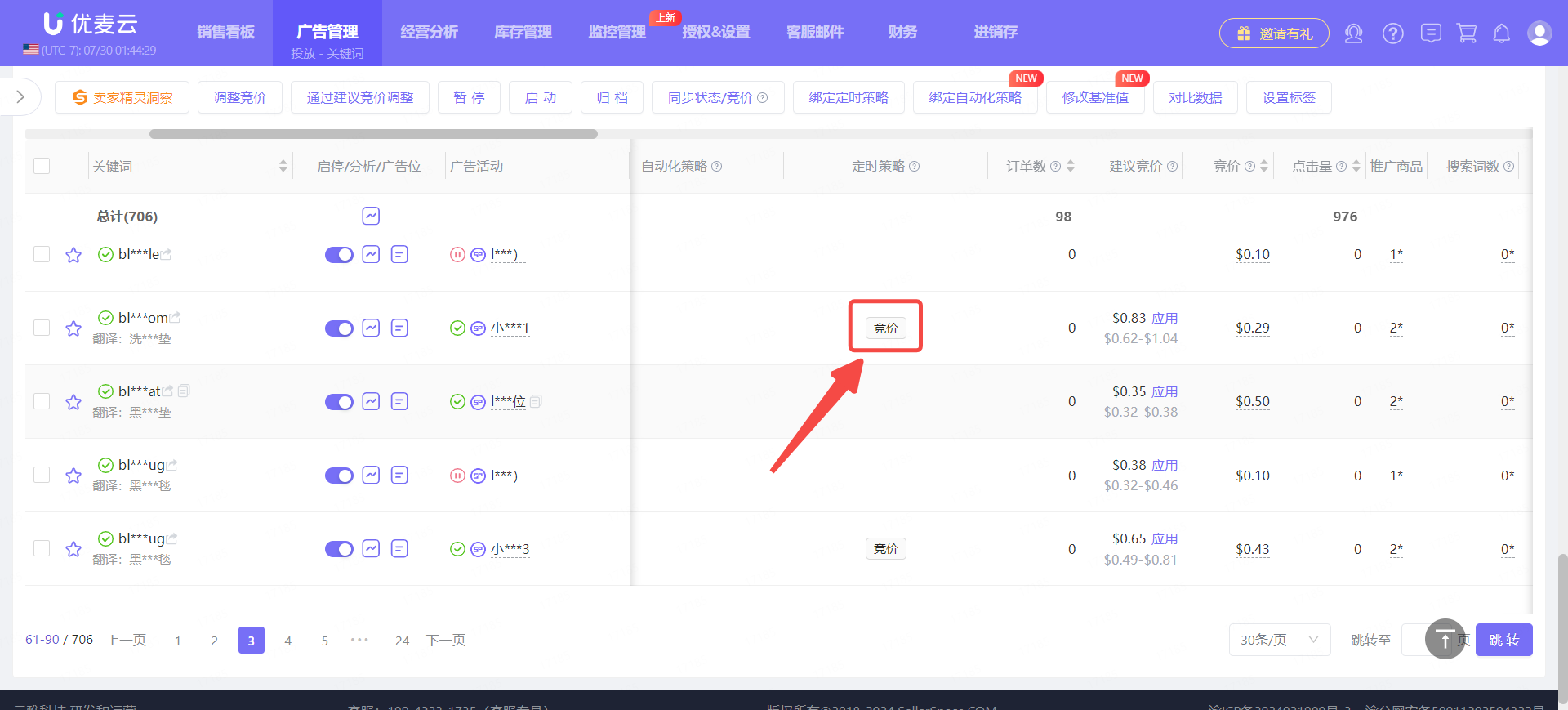 +
+
Scheduled Strategy details:
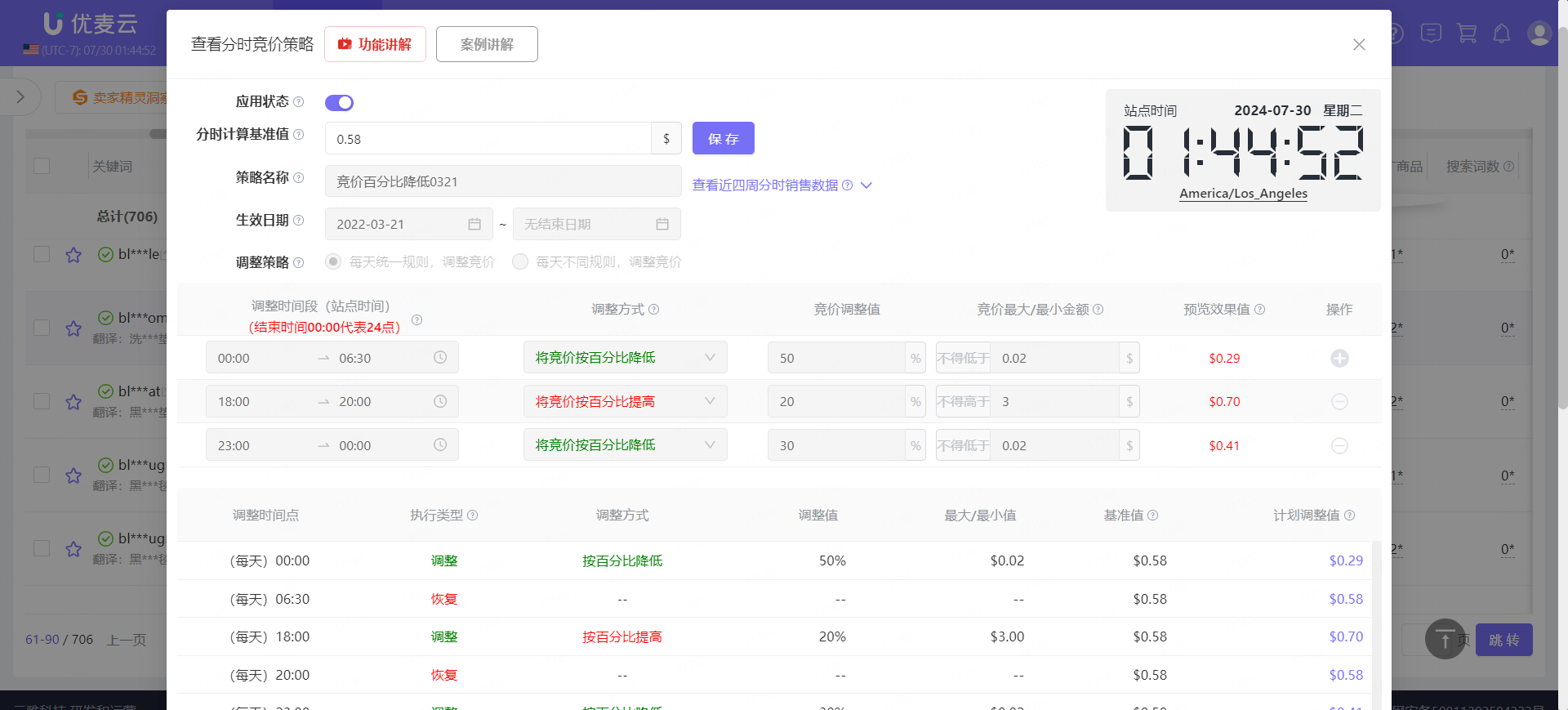 +
+
If you do not want a keyword to be bound to the current strategy, you can directly unbind it with one click.
Click 【×】 next to the strategy name to unbind.
 +
+
3.3 Automation Strategy
SellerSpace's 【Automation Strategy】 feature automatically analyzes historical and real-time data performance of Amazon Advertising based on seller-configured strategies. Based on ad performance, it automatically adjusts ad bids, budgets, ad placement, and other parameters. It also supports automatically expanding high-quality keywords from search terms, negating junk keywords, and pausing ads.
Analysis metrics include: Impressions, Clicks, CTR, Spend, CPC, Orders, CVR, CPA, Sales, ACOS, ROAS, Budget-to-Spend Ratio
Adjusted ad targeting values: Bid, Budget, Ad Placement, Pause, Keyword Expansion, Keyword Negation
Through flexible rule configuration and automated parameter adjustment, it helps sellers save labor costs, improve ad targeting efficiency, and achieve higher ad ROI.
Whether it is optimizing overall ad operations or conducting refined management for specific products or promotions, ad Automation Strategy can provide sellers with strong operational support.
Among them, Automation Strategies related to automatic adjustments and "keywords" can be viewed and unbound on the 【Targeting - Keywords】 page.
Automation Strategies related to targeted keywords: Automated Bidding, Automated Pausing, Automated Keyword Expansion, Automated Keyword Negation.
Find the keyword bound to an Automation Strategy, hover your mouse over the strategy name to view the status details of the Automation Strategy.
 +
+
Click the strategy name to enter to view the setting details of the strategy. For example, under what kind of performance automatic adjustments will be made, etc.
 +
+
Automation Strategy details page:
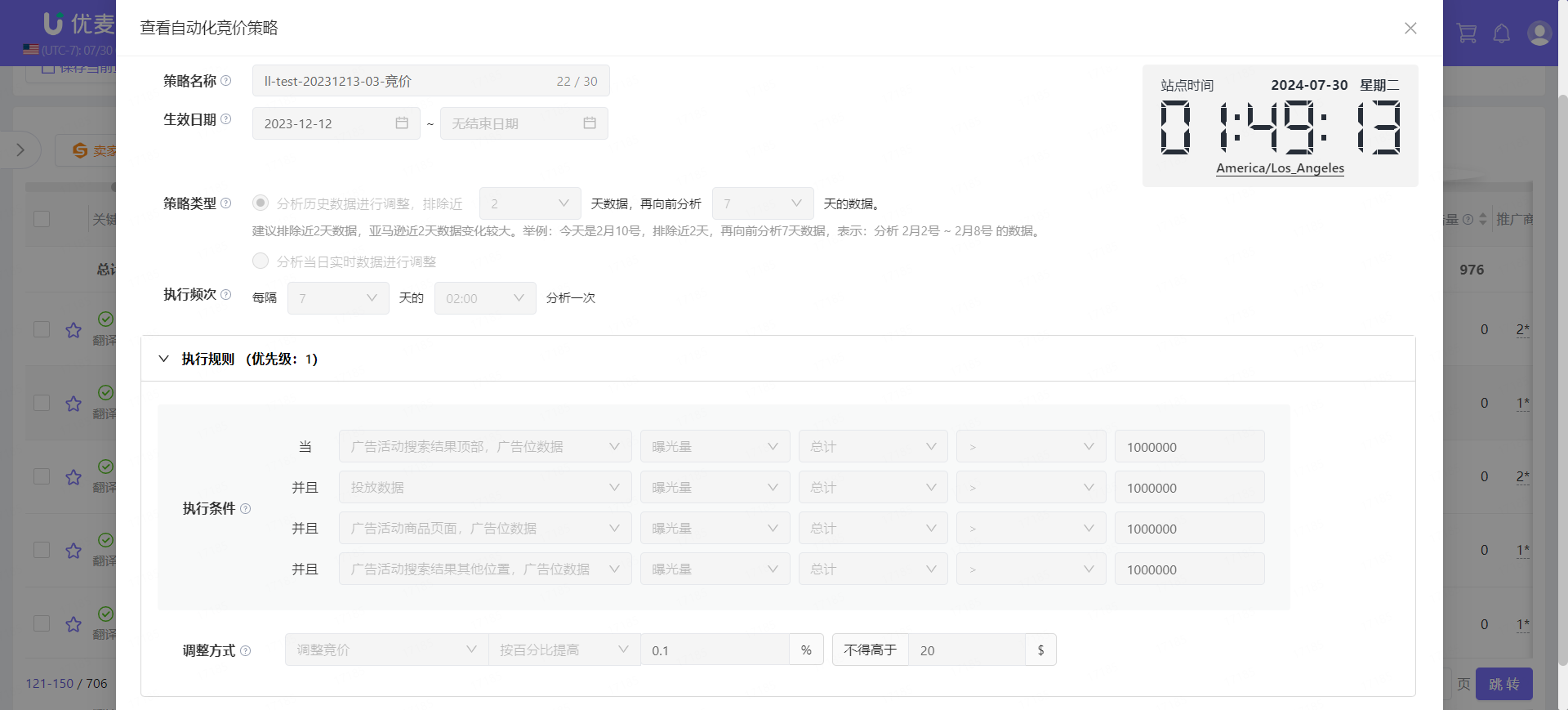 +
+
If you do not want a keyword to be bound to the current Automation Strategy, you can directly unbind it with one click.
Click 【×】 next to the strategy name to unbind.
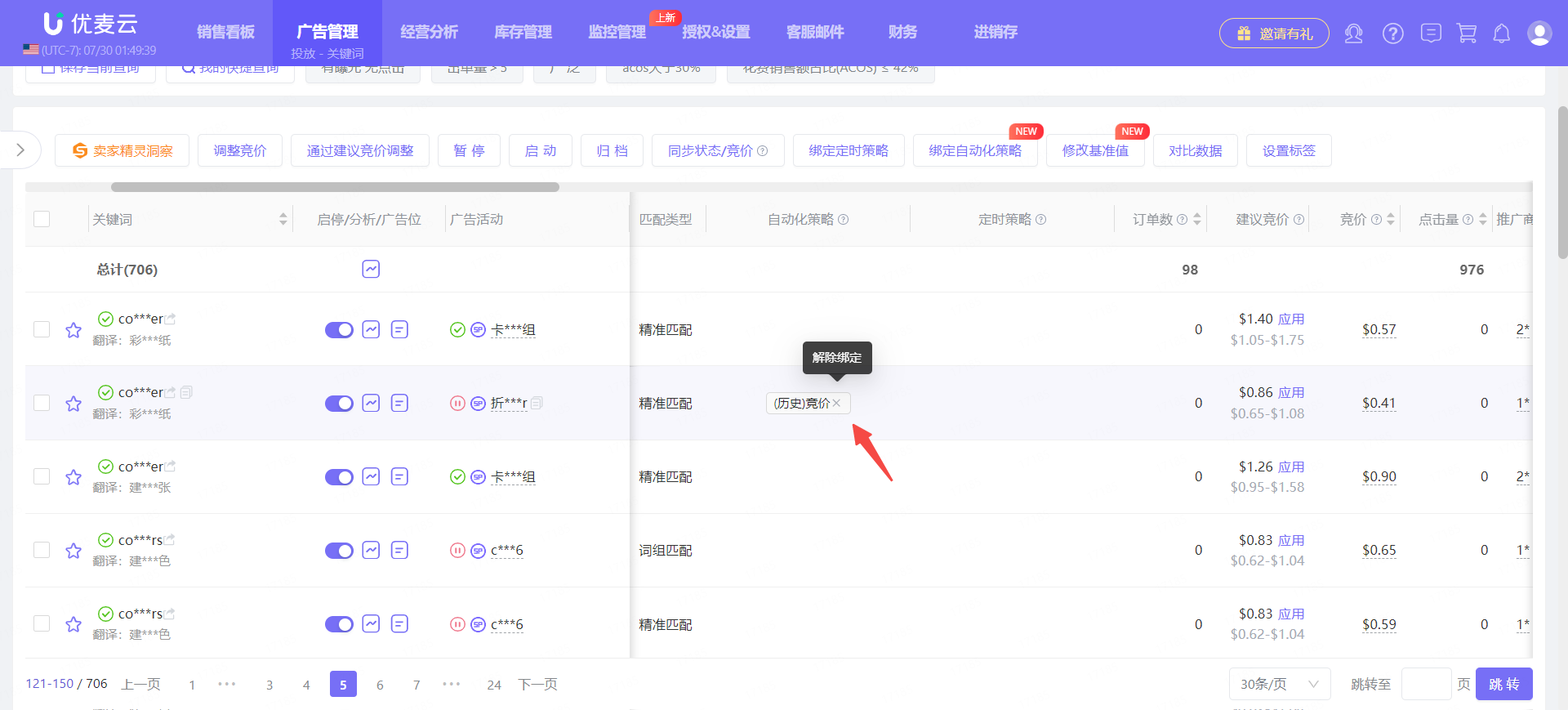 +
+





